Translated for Sott.net
boon.hu
Mon, 01 Mar 2010 19:40 EST
On Sunday night people noticed flashes and strong light phenomena in Miskolc, Kazincbarcika, Putnok, and Ózd.
The flashes and the strange lights might have been caused by a meteor,
Eva Egyedne Novodovszki, spokeswoman of the Borsod-Abauj-Zemplen County
Police Department, informed Borsod Online.
There were reports to the county police department of flashes
and thundering from several settlements at almost the same time on
Sunday night (23:20). The Catastrophe Protection Agency was informed
and it started an investigation into the case.
The surprisingly bright sky flashes were seen in Borsod
county, Budapest and also in Szabolcs county by lots of people Sunday
night.
Italian Meteor and TLE Network
Sun, 28 Feb 2010 10:47 EST
February 1
Fireball 2010.02.01 time 18:09
This beautiful fireball trail and several flashes were taken a few
minutes ago from the Ferrara station. It is likely that they were also
observed from the SOSO camp and from Diego's new station which faces
North from Rieti.
Fireball 2010.02.01_18.09.34 ± 1 U.T.
Beginning RA =66.253
Dec = -2.747
Ending RA = 70.641
Dec = -16.753
Time of transit: 2.16
Persistent train duration: 0.08
Flashes: 4
Apparent max magnitude: -5.10 ± 0.39
Zenithal magnitude : -6.43 ± 0.49
Note: Magnitude estimate, a check by experts is required please
Fireball 2010.02.01 time 20:56
Fireball 2010.02.01_20.56.14 ± 1 U.T.
Beginning RA =102.216
Dec = -18.652
Ending RA = 99.624
Dec = -30.077
Time of transit: 2.36
Persistent train duration: 0.00
Apparent max magnitude: -3.13 ± 0.39
Zenithal magnitude : -6.04 ± 0.75
Note: Fireball from the Ferrara video station, simultaneously with SOSO.
February 2
Another fireball from SOSO
Fireball 2010.02.02_04.40.45 ± 1 U.T.
Beginning RA =229.498
Dec = 9.555
Ending RA = 220.866
Dec = 4.453
Time of transit: 0.76
Persistent train duration: 0.12
Flashes: 1
Apparent max magnitude: -5.72 ± 0.07
Zenithal magnitude : -6.02 ± 0.07
February 3
Note: Also registered by us in Medelana.
Classified as a J5:Com with a magnitude of -2.1 during a night that showed up 16 more meteors.
[video]
February 5
Fireball 2010.02.05_01.43.17 ± 1 U.T.
Beginning RA =218.652
Dec = 52.610
Ending RA = 262.262
Dec = 68.546
Time of transit: 1,040 s
Persistent train duration: 4,280 s (estimated)
Fragmentation: 1
Flashes: 2
Apparent max magnitude: -12.72 ± 0.80
Zenithal magnitude: -13.47 ± 0.80
Meteor stream: J5-COM or SPOR
Note: The meteoroid is likely to be cometary in origin.
Unfortunately it was not picked up by other stations, because they were
under a thick and compact cloudy structure; typical frontal
meteorological situation.
February 12
2010.02.12_23.40.31 ± 1 U.T.
Beginning RA = n/a
Dec = n/a
Ending RA = n/a
Dec = n/a
Time of transit: n/a
Persistent train duration: n/a
Apparent max magnitude: n/a
Zenithal magnitude: n/a
Meteor stream: Geminides
February 14
Fireball 2010.02.14_04.01.2 ± 1 U.T.
Beginning RA =248.649
Dec = 21.154
Ending RA = 250.045
Dec = 16.185
Time of transit: 0.68
Persistent train duration: 0.00
Flashes: 1
Apparent max magnitude: -4.59 ± 0.5
Zenithal magnitude : -4.84 ± 0.5
February 18
Fireball 2010.02.18_22.40.0 ± 1 U.T.
Beginning RA =23.071
Dec = 62.576
Ending RA = 335.503
Dec = 58.785
Time of transit: 5.680 s
Persistent train duration: -
Fragmentation: 2
Flashes: 1
Apparent max magnitude: -5.48 ± 0.18
Zenithal magnitude: -10.78 ± 0.35
Note: Fragmentation and an elongated flare
[video]
February 26
Fireball 2010.02.26_21.39.45 ± 1 U.T.
Beginning RA =164.452
Dec = 17.752
Ending RA = 158.553
Dec = 9.015
Time of transit: 1,280 s
Persistent train duration 5,860 s (estimated)
Flashes: 1
Apparent max magnitude: -10,8 ± 0,7
Zenithal magnitude: -11,3 ± 0,7
3D reconstruction of the orbit
(Translation: SOTT editors)
Translated for Sott.net
Aktuality.sk
Tue, 02 Mar 2010 14:47 EST
This morning people from many parts of Slovakia are asking the
question: What caused the mysterious glow registered on Sunday night
just before midnight?
"Just before midnight I noticed a loud noise which words cannot describe. I saw the glow in the window. The whole event lasted about 5-6 seconds, but it was something extraordinary,"
we were informed by a reader from Tornale. The so far unexplained event
had been noticed in Rožňava near Košice and even in Hungary. Some
thought it looked like fireworks, others were afraid that an explosion
in some factory happened.
"I saw a bright light. I thought it was just lightning, but I
didn't hear the thunder. Even more so it was snowing at the time, that
is why I thought it was odd," was the reaction of a female student from
Východna.
The possibility of supersonic aircraft in the sky has
been ruled out by the Ministry of interior. "The events that you are
referring to were registered by us at around 11.20pm, we looked into
the matter and can confirm that it had nothing to do with the
activities of the Ministry of defence," said the spokesman for the
Ministry of defence Vladimir Gamela. According to the Commander of the
air force it was most likely a meteor above the northern and eastern
part of the country. "It was no rocket nor an airplane or anything
else. We examined the matter over our military line. Our radars, which
are part of the NATO system, did not register anything. The media as
well as the general public can obtain further details from astronomers,
that is if they managed to record this event," said Gemela.
Expert: it was an object from space that burned up
The secretary of the Astronomical institute of the Slovak
academy of sciences in Tatranska Lomnica Drahomír Chochol confirmed for
the News Agency of the Slovak Republic that this strange event was
indeed a meteor, space object, that entered the atmosphere. "When it
entered the atmosphere the object heated up and exploded," he added
that until now the Astronomical institute is sorting a mass of
information provided by the general public. "We were not able to
observe the phenomenon in the Tatras because of the overcast weather.
But we have information from the Czech Republic according to which they
registered a bolide, a light phenomenon associated with the explosion
of a meteor, with a magnitude of minus nine," added Chochol. According
to this information it should have been green colored object. "The
explosion probably occurred at an altitude of 30 kilometers near
Košíce. We will be able to determine the exact trajectory after three
scientific observations of the event are available," clarified Chochol.
The object could have been the size of a football and probably only
small fragments fell to the ground.
Did the meteorite fall near Bretka?
A crater should be near the village of Bretka located in the
eastern part of the country. It should have been caused by a meteorite
that fell on a Sunday night. This was the first information from a
reader on the website Aktuality.sk. The reader Zuzana hadn't seen it
herself but supposedly obtained the information from the local
firefighters: "They are keeping watch on the city to prevent people
getting irradiated," she further writes.
The Bretka municipal office did not either confirm or refute
this information. "We have heard about it but where this impact site is
supposed to be we do not know," said one employee of the office to
Aktuality. sk
Inhabitants from the Slovak town of Košice were frightened Sunday night by a bizzare light in the sky and a loud explosion followed by a shock wave. According
to astronomers apparently an object from space collided with the Earth
and shortly before impact most likely exploded in the atmosphere.
"It is most likely that Earth encountered an interplanetary object
about half a meter or a meter in diameter" said according to Slovakian
server SME.sk Drahomír Chochol from the Astronomical institute of the
Slovak academy of sciences (SAV) in Tatranská Lomnice. (read more on
SME.sk)
"At around eleven thirty a light appered in the courtyard
window and slowly began to glow brightly," stated a resident from the
village Jasov near Košice. "Not like lightning, but really slowly, until the room was lit like during the day." She continues, "we thought it strange that the dog didn't bark."
"After that the light faded and we heard the sound. The noise was similar to drumming, we felt pressure in our ears like when you stand next to speakers. It lasted at least a minute," the resident of Jasovanka described the Sunday event.
According to Chochol the object entered the atmosphere where friction
caused it to heat up and explode at an altitude of roughly 30
kilometres above the surface. The explosion was accompanied by light
that at its maximum brightness was a thousand times brighter than a full moon.
"It could have been one of the meteoroids that circle the Earth and it
sometimes happens that they collide with the Earth," said Chochol and
added that unfortunately astronomers do not have a scientific record of
the event. "Even though we have a point camera on Lomnický štít, at the
time it was overcast. Therefore we only have reports from individuals
and from them we are attempting to explain the event." he said.
The strange light had been captured in poor quality by one
camera, part of the European Point Network, but amateur images from
Prešov have also surfaced. But this will most likely be insuficient to
determine the impact site and for the overall reconstruction of the
object's movement. To get the exact calculation they need records from
at least three independent locations.
Comment: Notice that the camera is still shaking slightly after the light passes.
AN explosion heard by villagers in Goathland and Robin Hood's Bay on Thursday afternoon is thought to have been a sonic boom.
Whitby Gazette readers contacted the paper to say they heard the deafening noise at around 2.30pm.
The term sonic boom is commonly used to refer to the shocks caused by
the supersonic flight of an aircraft. They generate enormous amounts of
sound ...
Comment: Another overhead meteorite explosion?
What was that loud noise in Millston?
Mary Ann Wojtyla
Jackson County Chronicle
Wed, 03 Mar 2010 18:49 EST
There was a big noise in Millston that recently shook many houses.
It was not Fort McCoy because it only happened once. Fort McCoy usually likes to make a lot of noise and go on for hours.
I thought it might be a sonic boom. Maybe someone knows what it was. Send me a message if you know.

The crash at the end of the Cretaceous period doomed important planktonic plants.
The
extraterrestrial body that slammed into Earth 65 million years ago is
best known for killing off the dinosaurs. But it also snuffed out more
than 90% of the tiny plankton species that made up the base of the food
web in the oceans. By sifting through geological records of ancient
sediments from around the globe, palaeoceanographers have culled clues
about how the impact caused so much havoc.
The researchers report in Nature Geoscience1
today that the most severe extinctions of nannoplankton happened in the
northern oceans and that the ecosystems there took 300,000 years to
recover, much longer than in the south. Given that pattern, the
researchers speculate that the direction of the impact caused
long-lasting darkness in the Northern Hemisphere and metal-poisoning in
the northern oceans.
Nannoplankton with calcium-based shells were the primary photosynthetic
producers in the oceans until 65 million years ago, at the boundary
between the Cretaceous and Palaeogene periods. But 93% of those species
went extinct - along with ammonites, large marine reptiles such as the
plesiosaurs, and all the dinosaurs. The extinctions have been linked to
the Chicxulub impact crater, which is buried beneath the Yucatán
peninsula in Mexico.
To trace the geographical distribution of the
extinctions, Timothy Bralower from Pennsylvania State University in
University Park and his colleagues examined published records that
analysed fossil nannoplankton at 17 sites spread across the globe. They
found that up to 98% of species went extinct in the northern oceans,
whereas rates in the southern ocean were lower; the most southerly site
at the time lost 73% of its nannoplankton species. "There's an
incredibly strong correlation between extinction rate and latitude,"
says Bralower.
The Southern and Indian oceans fared better in other ways as
well. Species diversity was less affected, and the normal species
assemblages returned almost immediately. But it took up to 300,000
years after the impact for species diversity to recover in the northern
oceans, according to the researchers.
Phytoplankton probably influenced the restoration of the
entire marine ecosystem, says Bralower. Their slow recovery in the
north would have impeded the resurgence of the whole northern oceanic
food web.
Other researchers have previously detected latitudinal
differences in the catastrophe. North American land plants were
particularly hard hit compared with species on southern continents.
Geological evidence suggests that the body that hit Earth was
travelling from the southeast to the northwest. That kind of collision,
along with the planet's rotation, would have thrown up more debris over
the Northern Hemisphere and blocked out the sun for an extended period.
"Suppression of photosynthesis and darkness would explain the extinctions and the diversity drop," Bralower says.
Poisoned seas
But the delayed recovery in the north was a mystery. "You'd
expect that once it got light again, they would start flourishing
again. Why would it take up to 300,000 years to come to normal
diversity in the Northern Hemisphere?" comments Bralower.
The team tested several hypotheses, such as ocean cooling and
acidification, but decided that metal poisoning is the only mechanism
that could have caused that delay. They surmise that the impact spewed
heavy metals into the sky and that these landed mostly in the northern
oceans. High concentrations of metals can be toxic to living organisms
and inhibit reproduction. And the suppression of photosynthesis in the
north would have prevented plankton from taking up the toxic metals and
clearing them out of the surface ocean.
"Until this study, you could imagine no environmental
mechanism to inhibit the recovery of plankton after light conditions
were restored. So what we've done is put numbers on how long it took
for critical parts of the food chain to recover," Bralower says. "It
was staggeringly long."
Although several geoscientists are impressed by the
latitudinal differences reported in the new paper, they are sceptical
about the metal hypothesis.
"The reality is, the ocean is one big ocean," says Steven
D'Hondt, an oceanographer at the University of Rhode Island in
Narragansett. He says the ocean would mix in a thousand years and
spread any heavy metals around. To explain the different rates of
recovery, he says, he would "poke around in evolutionary ecology to
find possible explanations".
James Zachos, a palaeoceanographer from the University of
California, Santa Cruz, agrees. "I suspect these findings might be
telling us more about the ecosystem recovery process from severe
extinction, rather than about the extinction process," he says.
Previous studies of marine molluscs have shown that widespread
lineages survived the extinction better than ones with fewer species
and more restricted ranges, according to David Jablonski, a
palaeontologist at the University of Chicago in Illinois. The mollusc
data2
suggest that extinction intensity was fairly uniform across the globe,
says Jablonski. But he adds: "If you squint your eyes a little at my
data, high southern-latitude mollusc extinction is a little milder than
elsewhere."
According to Bralower, species that lived in the high southern
latitudes were adapted to low light and high metal concentrations and
this allowed them to survive the immediate effects of the impact.
"Adaptation is a critical factor in survivorship and the effect of the
impact is built on top of that," he says.
Even if nannoplankton in the south suffered less than those in
the north, it was "still a hell of a hit", says Jablonski. "No matter
what, it was a bad time to be phytoplankton at the end of the
Cretaceous period anywhere in the world."
References
1. Jiang, S., Bralower, T. J., Patzkowsky, M. E., Kump, L. R. & Schueth, J. D. Nature Geosci. online publication doi:10.1038/ngeo775 (2010).
2. Raup, D. M. & Jablonski, D., Science 260, 971-973 (1993).
Wed, 03 Mar 2010 21:00 EST
Duluth News Tribune
Several Northland residents reported seeing a flaming object in the sky about 7:15pm tonight.
Audrey Monicken, who lives on Duluth's Park Point, said she was watching television when she caught the sight.
"I saw a flaming thing come down out of the sky," she said.
She described the object as about the size of a mattress with red
flames, and said that it came down at an angle out of the sky. From her
vantage facing the harbor, Monicken said the object seemed to disappear
in the middle of the bay.
Brad Wick, a public information officer for the Duluth
Police Department, said dispatch received a handful of calls from
people who reported a fiery object in the sky. One person thought an
aircraft had crashed into the lake, but Wick said a call to the air
traffic control tower at Duluth International Airport indicated there
was no sign of an airplane in the area or in distress at the time of
the sighting.
The Duluth Police Department also received an inquiry about a flaming object in the sky from the Cook County emergency dispatch.
The National Weather Service in Duluth also received a report
from a Washburn County resident in the Spooner area, who described
seeing a fireball that traversed the horizon about the same time
tonight.
Tom Lonka, a meteorologist with the National Weather Service,
said it's possible the two reports could be explained by a meteorite or
a piece of "space junk," such as an old satellite, entering the Earth's
atmosphere. He said such events are not that rare, and the Weather
Service receives occasional calls about similar sightings.
CentralEastEurope.com
Tue, 02 Mar 2010 07:54 EST
A mysterious fireball was seen in the sky on the night of 28th Feb. It
was running through northern Hungary and made a huge blast and flash
above eastern Slovakia.
The authorities are still investigating whether it was a
meteor or something else. Wizz Air pilots also saw the huge shiny ball
of fire at 30,000 feet, while a Cathay Pacific flight also reported the
object, which was white rather than the normal yellowish a meteor gives
off.
The flashing light and blast caused minor panic in the
villages of northern Hungary, like Aggtelek or Roznava, Slovakia where
everyone woke up to the strange noise and light.
The fireball was also seen in Plzen, Czech Republic, which is more than 600kms away. NATO radars did not detect anything.
Andy Mannion
UK UFO Sightings
Thu, 04 Mar 2010 15:53 EST
Posted: March 2, 2010
Location of Sighting: Boughton, Northampton
Date of Sighting: 02/02/2010
Time: 7:10pm
Witness Statement: I was walking the dog
and suddenly became aware of these two very bright orange lights in the
sky. They were bigger than a plane and they seemed to be traveling at
quite a speed and quite far a part. They kind of looked like orangee
fireballs and one was following the other. About 2mins later they
disappeared, then another one came along with exactly the same
characteristics as the ones before and moving in the same direction.
None of these orange lights were making a sound and they didn't look like high flying planes!
Science Daily
Thu, 04 Mar 2010 21:37 EST
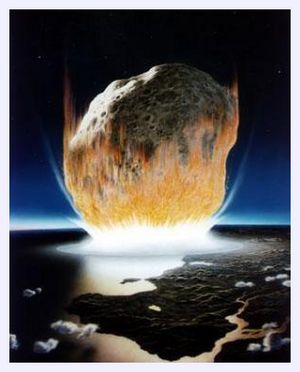
An
artist's rendering of the moment of impact when an enormous space rock
struck the Yucatán peninsula at the end of the Cretaceous Period.
The
Cretaceous-Tertiary mass extinction, which wiped out the dinosaurs and
more than half of species on Earth, was caused by an asteroid colliding
with Earth and not massive volcanic activity, according to a
comprehensive review of all the available evidence, published in the
journal Science.
A panel of 41 international experts, including UK researchers
from Imperial College London, the University of Cambridge, University
College London and the Open University, reviewed 20 years' worth of
research to determine the cause of the Cretaceous-Tertiary (KT)
extinction, which happened around 65 million years ago. The extinction
wiped out more than half of all species on the planet, including the
dinosaurs, bird-like pterosaurs and large marine reptiles, clearing the
way for mammals to become the dominant species on Earth.
The new review of the evidence shows that the extinction was
caused by a massive asteroid slamming into Earth at Chicxulub
(pronounced chick-shoo-loob) in Mexico. The asteroid, which was around
15 kilometres wide, is believed to have hit Earth with a force one
billion times more powerful than the atomic bomb at Hiroshima. It would
have blasted material at high velocity into the atmosphere, triggering
a chain of events that caused a global winter, wiping out much of life
on Earth in a matter of days.
Scientists have previously argued about whether the
extinction was caused by the asteroid or by volcanic activity in the
Deccan Traps in India, where there were a series of super volcanic
eruptions that lasted approximately 1.5 million years. These eruptions
spewed 1,100,000 km3 of basalt lava across the Deccan Traps, which
would have been enough to fill the Black Sea twice, and were thought to
have caused a cooling of the atmosphere and acid rain on a global
scale.
In the new study, scientists analysed the work of
palaeontologists, geochemists, climate modellers, geophysicists and
sedimentologists who have been collecting evidence about the KT
extinction over the last 20 years. Geological records show that the
event that triggered the extinction destroyed marine and land
ecosystems rapidly, according to the researchers, who conclude that the
Chicxulub asteroid impact is the only plausible explanation for this.
Despite evidence for relatively active volcanism in Deccan
Traps at the time, marine and land ecosystems showed only minor changes
within the 500,000 years before the time of the KT extinction.
Furthermore, computer models and observational data suggest that the
release of gases such as sulphur into the atmosphere after each
volcanic eruption in the Deccan Traps would have had a short lived
effect on the planet. These would not cause enough damage to create a
rapid mass extinction of land and marine species.
Dr Joanna Morgan, co-author of the review from the Department
of Earth Science and Engineering at Imperial College London, said: "We
now have great confidence that an asteroid was the cause of the KT
extinction. This triggered large-scale fires, earthquakes measuring
more than 10 on the Richter scale, and continental landslides, which
created tsunamis. However, the final nail in the coffin for the
dinosaurs happened when blasted material was ejected at high velocity
into the atmosphere. This shrouded the planet in darkness and caused a
global winter, killing off many species that couldn't adapt to this
hellish environment."
Dr Gareth Collins, Natural Environment Research Council Fellow
and another co-author from the Department of Earth Science and
Engineering at Imperial College London, added: "The asteroid was about
the size of the Isle of Wight and hit Earth 20 times faster than a
speeding bullet. The explosion of hot rock and gas would have looked
like a huge ball of fire on the horizon, grilling any living creature
in the immediate vicinity that couldn't find shelter. Ironically, while
this hellish day signalled the end of the 160 million year reign of the
dinosaurs, it turned out to be a great day for mammals, who had lived
in the shadow of the dinosaurs prior to this event. The KT extinction
was a pivotal moment in Earth's history, which ultimately paved the way
for humans to become the dominant species on Earth."
In the review, the panel sifted through past studies to
analyse the evidence that linked the asteroid impact and volcanic
activity with the KT extinction. One key piece of evidence was the
abundance of iridium in geological samples around the world from the
time of the extinction. Iridium is very rare in Earth's crust and very
common in asteroids. Immediately after the iridium layer, there is a
dramatic decline in fossil abundance and species, indicating that the
KT extinction followed very soon after the asteroid hit.
Another direct link between the asteroid impact and the
extinction is evidence of 'shocked' quartz in geological records.
Quartz is shocked when hit very quickly by a massive force and these
minerals are only found at nuclear explosion sites and at meteorite
impacts sites. The team say that an abundance of shocked quartz in rock
layers all around the world at the KT boundary lends further weight to
their conclusions that a massive meteorite impact happened at the time
of the mass extinction.
The panel was able to discount previous studies that suggested
that the Chicxulub impact occurred 300,000 years prior to the KT
extinction. The researchers say that these studies had misinterpreted
geological data that was gathered close to the Chicxulub impact site.
This is because the rocks close to the impact zone underwent complex
geological processes after the initial asteroid collision, which made
it difficult to interpret the data correctly.
Nuremberg, Germany - A new German-led study has marshalled even more
powerful evidence that a single meteor strike 65 million years ago led
to the sudden extinction of all the earth's dinosaurs. That theory has
dominated dinosaur studies for a couple of decades, but has remained
unproven, with some dissidents saying a monstrous volcanic eruption in
India caused the extinction.
Peter Schulte of the University of Erlangen and Nuremberg said
evidence turned up by scientists in recent years indicated the impact
on what is now the Yucatan peninsula of Mexico was the cause.
The review by 41 scientists was published Thursday in the journal Science.
"When one assembles all the new information we have got in the recent
past, the single big impact explanation is the only one that holds up,"
said Schulte. "But we don't have exact proof, and perhaps we never
will," he added.
The impact site, the Chicxulub Crater, is 200 kilometres
across. The scientists say earthquakes and tsunamis killed every living
thing in a radius of 1,500 kilometres. The fossil record shows two
thirds of earth's flora and fauna died out after the impact.
The projectile was 10,000 metres across and hit at about 20 times the velocity of a rifle bullet.
"The most fatal effect was what happened afterwards: the huge
amount of dust and soot that got into the atmosphere. At the same time,
a vast amount of sulphur from rock beneath the peninsula escaped,"
Schulte explained.
The murky skies stopped sunlight reaching the earth for several years and the world cooled.
"That wrecked many of the food chains," said Schulte, pointing
to evidence of massive decline in oceanic plankton populations and the
death of forests. That killed off herbivores, leaving no food for
meat-eaters. More information: http://doi.org/10.1126/science.1177265
David Shiga
New Scientist
Fri, 05 Mar 2010 13:49 EST
An
infrared space telescope has spotted several very dark asteroids that
have been lurking unseen near Earth's orbit. Their obscurity and tilted
orbits have kept them hidden from surveys designed to detect things
that might hit our planet.
Called the Wide-Field Infrared Survey Explorer (WISE), the new
NASA telescope launched on 14 December on a mission to map the entire
sky at infrared wavelengths. It began its survey in mid-January.
In its first six weeks of observations, it has discovered 16
previously unknown asteroids with orbits close to Earth's. Of these, 55
per cent reflect less than one-tenth of the sunlight that falls on
them, which makes them difficult to spot with visible-light telescopes.
One of these objects is as dark as fresh asphalt, reflecting less than
5 per cent of the light it receives.
Many of these dark asteroids have orbits that are steeply
tilted relative to the plane in which all the planets and most
asteroids orbit. This means telescopes surveying for asteroids may be
missing many other objects with tilted orbits, because they spend most
of their time looking in this plane.
Fortunately, the new objects are bright in infrared radiation,
because they absorb a lot of sunlight and heat up. This makes them
relatively easy for WISE to spot.
Ex-comets
"It's really good at finding the darkest asteroids and comets," said
mission team member Amy Mainzer of NASA's Jet Propulsion Laboratory in
Pasadena, California, at the Lunar and Planetary Science Conference in
Houston, Texas, on Thursday.
WISE is expected to discover as many as 1000 near-Earth
objects - but astronomers estimate that the number of unknown objects
with masses great enough to cause ground damage in an impact runs into
the tens of thousands.
Richard Binzel of the Massachusetts Institute of Technology
says the dark asteroids may be former comets that have long since had
all the ice vaporised from their exteriors, leaving them with inactive
surfaces that no longer shed dust to produce tails. He points out that
many comets have very tilted orbits, and comets visited by spacecraft
have been observed to have very dark surfaces.
A bluish green fireball flew over the bright sky in the East - and the
Southern sky on Tuesday, at almost quarter past eight in the evening.
The entire event lasted 4-5 seconds.
Knut Jørgen Røed Ødegaard would like to get a hold of this object.
This was a super powerful meteorite, and it could have fallen
in Norway. Most of them explode in the atmosphere, but the large ones
can reach the ground, says Ødegaard.
It would have been fun to get know whether people had seen or heard something.
There are two meteor showers happening in the sky this week and one of
the fiery rocks may have landed just across the river near Hudson.
People living east of the city saw bright flashes and a burning object fall from the sky.
Reports to the local newspaper describe the odd flash, even explosion with a multi-colored tail from Hudson to New Richmond.
According to the American Meteorological Society, February,
March and April bring the highest occurrence of fireballs and unusually
bright meteors.
Duluth News Tribune
Fri, 05 Mar 2010 06:57 EST
Several Northland residents reported seeing a flaming object in the sky about 7:15 p.m. Wednesday.
Audrey Monicken, who lives on Duluth's Park Point, said she was watching television when she caught the sight.
"I saw a flaming thing come down out of the sky," she said.
She described the object as about the size of a mattress with red
flames, and said that it came down at an angle out of the sky. From her
vantage facing the harbor, Monicken said the object seemed to disappear
in the middle of the bay.
Brad Wick, a public information officer for the Duluth Police
Department, said dispatch received a handful of calls from people who
reported a fiery object in the sky. One person thought an aircraft had
crashed into the lake, but Wick said a call to the air traffic control
tower at Duluth International Airport indicated there was no sign of an
airplane in the area or in distress at the time of the sighting.
The Duluth Police Department also received an inquiry
about a flaming object in the sky from the Cook County emergency
dispatch.
The National Weather Service in Duluth also received a report
from a Washburn County resident in the Spooner area, who described
seeing a fireball that traversed the horizon about the same time
Wednesday night.
Tom Lonka, a meteorologist with the National Weather Service,
said it's possible the two reports could be explained by a meteorite or
a piece of "space junk," such as an old satellite, entering the Earth's
atmosphere. He said such events are not that rare, and the Weather
Service receives occasional calls about similar sightings.
WA Museum curators will investigate claims a meteorite crashed into a home of a north-eastern suburb in Perth.
A museum spokesman said a woman had claimed a meteorite hit her Beechboro home last night.
"All we know is a house has been hit by a suspected meteorite but we
have not had a chance to verify this," a museum spokesman said.
"We are trying to get it over to the museum for one of our
scientists to have a look at but at this stage we do not know if it's a
rock or a meteorite."
Perth Observatory said it had received a "couple of
reports" last night from people phoning to say they had seen a light in
the sky.
"At this stage no one seems to be able to put it all together,
but if it was a meteor it belongs to the WA Government, observatory
astronomer Ralph Martyn said.
"The reports at this stage are very sketchy."
He said the observatory was waiting to inspect a photograph of the object.
"A lot of people find slag out of glass furnaces and think they are meteorites as well, they kind of look the same."
Stephen Largen
The New Star.com
Tue, 09 Mar 2010 22:30 EST
Louisiana - A loud sound similar to an explosion that rattled windows
in the region late Monday afternoon was most likely a sonic boom caused
by high-speed aircraft or a meteor coming through the atmosphere, a
pair of local experts said.
The apparent sonic boom happened just before 5 p.m. and affected the area southwest of Shreveport to around Vidalia.
"Looking at the path of the reports, there's a definite linear
path," said Don Wheeler, a meteorologist at Louisiana Delta Community
College.
Wheeler said there was no irregular seismic activity in the
area during the period immediately before and after the apparent sonic
boom.
"If indeed there was a meteor, they can come in at supersonic speeds," Wheeler said.
There have been no reports of area residents seeing a meteor, but
seeing a meteor was unlikely because overcast and daytime conditions,
Wheeler said.
John Anderson, an assistant professor of physics at the
University of Louisiana at Monroe, said the more likely culprit behind
the sonic boom is a jet or high-speed airplane.
Anderson said the aircraft could have moved over the affected
area in about 90 seconds if it was travelling at 750 miles per hour or
faster.
"If it was an airplane, somebody's in trouble," he said.
Some residents reported seeing two planes.
A spokesman for the Federal Aviation Administration did not return a call and an e-mail seeking comment.
"There's a lot of questions and few answers," Wheeler said.
New Hampshire - A suspected meteor shower lit up the night skies over Derry at the weekend.
The celestial objects were spotted shooting across the sky in the early
hours of Sunday morning by Derry man Niall Smith who says he saw the
meteors as he drove up Brookhill at around 1230am.
"There were six of them in total," he told the Journal yesterday.
"They were bright orange almost red, like balls of flames burning with a tail behind them."
"It was an exhilarating experience to see them," he said.
He said the lights passed over the hills of Donegal before disappearing from view.
John McFarland of the Armagh Planetarium yesterday confirmed at least
one meteor would have been present over Derry in the early hours of
Sunday.
"While we have nothing on our cameras for the time suggested at least one meteor passed over at around 1:37am," he said.
Meteor showers are caused by small fragments of cosmic debris entering the earth's atmosphere at extremely high speed.
They vaporise due to pressure from the air, leaving a streak of
light that can be seen from the earth but usually disappears very
quickly.
California - We also saw the meteor a letter writer described recently.
We were returning to Lompoc from Santa Maria on Highway 1. We spotted the fireball just as we crossed San Antonio Creek Road.
As we drove up the grade, it traveled from left to right until out of
sight, as we neared the top of the hill. It seemed like it was visible
for a full 180 degrees in our field of view.
We marveled that it was big enough to keep burning all that
time and distance. We speculated whether it hit land or could have
ended in the ocean.
We, too, expected to hear someone else and the news outlets talk about it.
Wickie Rodenhi
Stephen Largen
The News Star.com
Wed, 10 Mar 2010 22:49 EST
A meteor hurtling through the atmosphere faster than the speed of sound
likely caused the sonic boom that startled many north Louisiana
residents late Monday afternoon.
The apparent sonic boom happened just before 5 p.m. and affected the area southwest of Shreveport to around Vidalia.
Experts had suggested Tuesday the sonic boom could have been caused by high-speed aircraft or a meteor.
Lawrenceville, Ga. resident David Jones was driving on Interstate 85 in Atlanta early Monday night when he noticed a large, electric blue ring-shaped cloud in the western sky.
The amateur astronomer and lifelong weather watcher snapped a
photo of the noctilucent cloud that likely formed when water molecules
surrounded meteor dust particles stirred up when a meteor moved through
the atmosphere.
Noctilucent clouds are rare and typically only form in polar regions.
Louisiana Delta Community College meteorologist Don Wheeler examined
the photo and believes it's directly related to the apparent sonic
boom.
"It makes very good sense," Wheeler said. "The cause of it is definitely pointing to a meteor."
Wheeler said he received a call Wednesday from a Bunkie
resident who claims she saw a grey mass with no flames moving through
the sky about the same time Monday.
The lack of flames could mean the meteor didn't burn and
reached the ground, likely somewhere in a low-traffic, wooded area,
Wheeler said.
Some Memphis residents also reported seeing a gray mass hurtling through the sky late Monday afternoon.
Meanwhile, the Federal Aviation Administration is investigating the noise that rattled windows.
"We had several inquiries about the noise, but have no firm answer as to what it was," FAA spokesman Lynn Lunsford said.
"A sonic boom is a possibility we're looking into, but it's possible we may not get a firm answer."
Comment: This is an update to an earlier story.
Deforestation has revealed what could be a giant impact crater in Central Africa, scientists say.
The 36-46km-wide feature, identified in DR Congo, may be one of the largest such structures discovered in the last decade.
Italian researchers considered other origins for the ring, but say these are unlikely.
They presented their findings at the recent Lunar and Planetary Science Conference in Texas, US.
The ring shape is clearly visible in the satellite image by TerraMetrics Inc reproduced on this page.
Only about 25 terrestrial impact craters are of comparable size or
larger, according to the web-based Earth Impact Database.
Giovanni Monegato, from the University of Padova, said the
feature was revealed only after trees were cleared from the area over
the last decade.
The Unia River flows around the ring structure, underlining
its round shape. The central part of the Wembo-Nyama feature is
irregular and about 550m in elevation.
This is about 50-60m higher than the depression where the
river flows. Although this might sound counter-intuitive, experts say
that impact craters can sometimes lift up dense rocks. The surrounding
rocks may subsequently erode, leaving a dome.
Confirmation needed
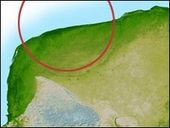
LARGEST IMPACT CRATERS
The Chicxulub crater is buried under Mexico's Yucatan Peninsula
*Vredefort: S Africa, 300km-wide, 2 billion years old
*Sudbury: Canada, 250km-wide, 1.8 billion years old
*Chicxulub: Mexico, 170km-wide, 65 million years old
*Popigai: Russia, 100km-wide, 35.7 million years old
*Manicouagan: Canada, 100km-wide, 214 million years old
The
putative crater lacks a well-defined outer ridge, though the University
of Padova team says this could be explained by deep weathering and
erosion in the tropical climate.
They add that the drainage pattern in the ring is very similar to those found in large impact craters in humid environments.
Mr Monegato said the team would now have to travel to the
region to carry out field studies. Researchers would examine rocks from
the site for tell-tale signs associated with space impacts.
These might include shocked quartz - a form of the mineral
which occurs where rocks have been hit suddenly by a massive force. It
is found only at nuclear explosion sites and at asteroid impact sites.
Finding such evidence will be crucial to confirm an impact origin over other processes which might explain the structure.
The researchers have considered whether volcanism or salt
diapirism (a process where evaporite minerals intrude vertically into
surrounding rock, forming dome-like structures on the surface) could be
responsible for the annulus.
But Mr Monegato and his colleagues say the known geology of
the region - along with other features of the structure (for example,
no known salt diapirs reach such a great size) - appear to rule out
such explanations.
"I am quite optimistic about an impact crater origin for this ring," Mr Monegato told BBC News.
If it is an impact structure, the scientists estimate it could
have been punched into the crust by a space rock measuring about 2km
across.
Further studies will be required to accurately determine an age for the ring, but it appears to post-date the Jurassic Period.
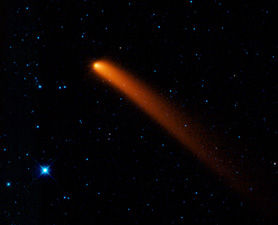
Comet
Siding Spring appears to streak across the sky in this infrared image
from NASA's Wide-field Infrared Survey Explorer, or WISE.
A new infrared telescope has found 16 previously unknown asteroids that swing close to Earth.
A new infrared telescope has found 16 to 20 previously unknown asteroids that come close to Earth.
The asteroids are dark, with most reflecting less than one-tenth of the
sunlight that hits them. One object is as dark as asphalt, reflecting
less than 5 percent of its light.
The objects, which some scientists suspect may be spent comets, pose no threat to the planet, though how they got here remains a mystery.
"This population tells us a lot about the solar system's
history and formation," said NASA's Amy Mainzer, the lead researcher on
a project to use a new infrared telescope called WISE to search for
near-Earth objects.
The Wide-Field Infrared Explorer, or WISE, has been on
the hunt for about seven weeks, mapping the sky for objects that
radiate in the infrared. Within six months, WISE is expected to have
surveyed the entire sky.
"We're just getting the first data on asteroids in general,"
Mainzer told Discovery News. "It's still really, really early so we
don't have an idea of how big this population actually is."
About half of the newly found objects reflect less than 10
percent of the sunlight that hits them, making them difficult if not
impossible to spot with visible light telescopes. WISE finds objects by
their heat emissions.
The newly discovered objects have highly inclined orbits,
which has planetary scientist Richard Binzel, with the Massachusetts
Institute of Technology, thinking that they are comets which have had
all their surface ices striped away by heating, leaving just a comet
nuclei orbiting in the inner solar system.
Comets are believed to have formed in the frozen outer regions
of the solar system, but occasionally some are bumped in closer to the
sun due to the gravitational pull of the giant planet Jupiter. As they
orbit closer to the sun, ices on their surface vaporize, forming a
distinctive fuzzy tail around the comet's body. Binzel believes WISE is
finding extinct comets.
"We're constantly finding new stuff," Mainzer said. "We're
drinking from the fire hose of knowledge right now. What we've seen is
a very exciting glimpse of what is to come."
New Port Richey -- Many residents of Pasco County are still wondering: what was that boom they heard Wednesday night?
The Pasco County Sheriff's Office received about 20 calls from around the county reporting a loud boom around 5 p.m.
Sheila Perry lives in Millpond Estates in New Port Richey. She said the boom rattled the windows and shook her house.
"First, I thought do we have earthquakes here because there's been so
many earthquakes," she said. "I just have never had anything shake the
house like that before."
Officials think it might have been a sonic boom or sound waves, but no one is really sure.
The sheriff's office said it doesn't have any information about military operations or explosions in the area.
No damage was reported as a result of the boom.
A newly-discovered comet is plunging toward the sun and probably will not survive. The encounter is too close to the sun for human eyes to see, but the Solar and Heliospheric Observatory (SOHO) is able to monitor the action using an opaque disk to block the sun's glare.
The doomed comet is probably a member of the Kreutz sungrazer family.
Named after a 19th century German astronomer who studied them in
detail, Kreutz sungrazers are fragments from the breakup of a giant
comet at least 2000 years ago. Several of these fragments pass by the
sun and disintegrate every day. Most are too small to see but
occasionally a big fragment--like this one--attracts attention.
Click here to launch a 12-hour time-lapse animation
Keep an eye on SOHO for the latest images.
Randy Hanson
Hudson Star-Observer
Wed, 10 Mar 2010 13:04 EST

Members
of the Pierce and Jacobson families pose near the spot where some of
them witnessed a meteor pass over the town of Hudson. Lisa Pierce, back
left, contacted the Star-Observer about the sighting, resulting in
comments on www.hudsonstarobserver.com from many other readers who saw
the meteor. Pierce is with, front from left, her son Charlie, neighbor
children Emma and Sam Jacobson, and son Michael, back right.
Hudson-area
residents lucky enough to have been looking at the stars sometime
before 8 p.m. Wednesday, March 3, were treated to what will no doubt be
a once-in-a-lifetime sight.
Judging from reader comments on the Star-Observer's Web site, a rare meteor fireball passed over the community at a low altitude.
Michelle Judge, who lives about five miles east of Hudson on
the south side of I-94, was returning to her house from doing chores in
the barn when she saw the fireball.
"I could see the actual fire in a ball. It was very good-sized -- and it was totally quiet," Judge said when contacted by the Star-Observer, after reporting the sighting online.
Judge said the fireball traveled almost directly west at an altitude of what she thought wasn't more than a few hundred feet.
It disappeared over her field, Judge said, "and then the rumble came and the turkeys went crazy."
She was referring to the thunder-like sound that followed the meteor, as reported by numerous Star-Observer online readers.
The sound awoke and startled the wild turkeys roosting near her home, Judge said.
"Or it hit them," she joked. "We may have turkeys out there for dinner."
Judge said the ball was red and yellow in color.
"It was like I was looking right into my stove," she said.
It didn't have a tail, she said, and appeared to be a couple of feet in diameter.
"You would have had to see it to believe it. It was really
something," said Judge, an information coordinator for Northwest Food
Products in North Hudson.
Judge said her daughter was in the house taking a shower, but she heard the explosion, too.
The two were convinced that the meteor had crashed to earth nearby and went looking for evidence of it. They didn't find any.
Curtis and Ann Waterhouse were in the outdoor hot tub at their
residence north of the Hudson Soccer Association complex on County UU
when the fireball passed over.
Curtis was leaning back in the tub, gazing at the stars, and got the best view of it.
He said he saw what first appeared to be a falling star.
"When it hit the atmosphere it just lit everything up,"
Waterhouse said. "As it was crossing over you could see it was starting
to break up. There were five or six tails all grouped together,
flashing different colors, red out front and kind of bluish and white
through the tails."
Waterhouse said he watched it perhaps two seconds before it dissipated.
"I thought for sure it landed in the cities somewhere," he said. "It just seemed incredibly close."
He said it was perhaps 30 seconds later that he heard soft
rumbling in the distance, which he judged to be sonic booms from when
the meteor entered the atmosphere.
Lisa Pierce, a resident of Prairie Meadows Drive just east of
Badlands Sno-park in the town of Hudson, began the media coverage of
the event by sending an e-mail to the Star-Observer asking if the
newspaper knew what caused the flash of light and thundering sound.
She was inside her home when a flash of light came through the windows, followed by what sounded like an explosion.
Pierce said she first thought it was lightning, but then observed that the sky was clear.
Pierce's neighbors Michelle and Nathan Jacobson, and their
children Emma and Sam, were delivering Girl Scout cookies and saw the
meteor.
Dr. Eileen Korenic, an astronomy professor at UW-River Falls,
said she believes people saw a meteor from the Pi Virginids shower
enter the atmosphere, judging from the many similar reports.
Korenic said people who saw the fireball are extremely fortunate.
"It is very rare to see a fireball. Rarer still to hear one,"
she said. "Rarer still to see it coming out of the Pi Virginids, and at
8 o'clock at night."
"So lots of very rare things came together for those lucky people who saw it," Korenic said.
She said it's possible that fragments from the meteor reached
the ground. But, usually, the pieces are so small that they're hard to
find, she said.
Some fireballs are large enough to cause the air to expand
when they enter the atmosphere, which produces the thunder, according
to Korenic.
"It is quite rare. It sounds like a sonic boom for some people. It can actually get that loud," she said.
People from Clear Lake to Prescott witnessed the meteor, according to the Star-Observer Web site comments.
Eldiaro24.com
Wed, 10 Mar 2010 09:19 EST
A glittering stone caught a woman's attention Fiambalá, Argentina, the rock with now be analyzed by specialists.
Some inhabitants of the Catamarcan town Fiambalá (in the Northwest of
Argentina) claim to have seen a meteorite and its fragments fall last
Monday night. A woman found them, and they will now be analyzed by
specialists from The National University of Catamarca.
The event took place in Juan Manuel Salas, one of Fiambalá's
quarters, in the Tinogasta Department, situated at approximately 350km
in the West of the province's capital where its inhabitants claim a
fireball fell at about 10 p.m., followed by a trail of light.
The neigbors thought that this could be a meteorite, no bigger than a football.
Norma Olmedo, who lives in the area, declared today for the
radio station FM Ancasti that she filmed the fall with her cell phone
which was how she was able to locate the fragments.
Olmedo, who at that time was with her son, stated that
"Monday, after 10 p.m., a source of light" lit up the sky behind her
and caught her attention.
As she turned around, she "saw a reddish ball falling from the sky, leaving behind a very bright trail", she declared.
She claims that on arriving in the area where she and her son
believed the fireball hit the ground, she discovered "a stone that was
still glittering".
In the meantime, this morning The National University
of Catamarca informed that a group of its specialists and of those
belonging to the Direction of anthropology would travel to Fiambalá in
the afternoon in order to establish a report on the alleged meteorite.
Citrus Daily
Fri, 12 Mar 2010 22:32 EST
Military jets performing training maneuvers over Gulf of Mexico waters
are being credited with creating sonic booms heard along Florida's west
coast earlier this week, to include Pasco, Hillsborough, Marion, Levy,
Hernando and Citrus counties.
The sheriff's offices in Pasco and Citrus counties have said
the most likely explanation is that jets based at Eglin AFB in
Florida's Panhandle had created the booms that shook windows and
rattled dishes.
That was confirmed by an Eglin AFB Public Affairs spokesman,
who said the "atmospheric conditions" most likely caused the booms to
be heard as the military was performing maneuvers over the Gulf.
Military exercises have been going on over Gulf waters
for decades, and this week's reports of "booms" being heard is not the
first time sonic booms have caused public confusion.
In November 2009, the Sun Herald newspaper in
Mississippi reported a story about this same "mystery" that covered a
large swath of Mississippi waters. The newspaper noted that Eglin is
the base that controls military training ranges - airspace over the
Gulf of Mexico used for military maneuvers in that part of the Gulf. An
Eglin AFB spokesman said, however, that the type of jet being flown at
the time of the booms would not produce sonic booms because they
weren't fast enough. [ Story here ]
In March 2009, other booms were reported near Mobile, Ala. and
Pensacola by WKRG-TV. Reports had the TV station checking out
possibilities for the source of the booms, such as earthquakes, Eglin
AFB, sheriff's offices and emergency management officials. [ Story Here ]
8:48 p.m.
Fire Chief James Shelly told News 5 there was no explosion in
Theodore. He heard the loud noise and says it shook things pretty good.
Shelly said he thinks it was a sonic boom.
4:21 p.m.
News 5 has received reports from Spanish Fort to the Mississippi
state line about a big boom around 2:00 p.m. that shook their homes.
We've done some digging, but so far, no one has an answer for us.
The National Weather Serve had no reports and suggested we check with the US Geological Survey.
The USGS
is not showing any signs of seismic activity in our area. In fact, the
closest earthquake to Mobile within the past week was 718 miles away in
Sullivan, Missouri on Saturday night.
Eglin Air Force Base says they are not doing any training flights this afternoon which could've caused a sonic boom.
And both the Mobile County Sheriff's Office and EMA report nothing unusual.
But something definitely happened and it caused a lot of
concern. Especially for a West Mobile woman who says dishes fell out of
her cabinets and broke on the floor.
We'll keep looking into the mystery and let you know what we find out.
At first glance it looks like aliens are using the sun for target
practice. A string of bullet-shaped streaks of light appear to be
shooting straight toward the sun.
These are proverbial snowballs in Hell, plunging 300 miles per second toward a fiery end in the sun's atmosphere.
The NASA/ESA Solar and Heliospheric Observatory (SOHO) observed the demise of one comet fragment on March 12.
The wayward comets are called sungrazers.
They are a class of comet that likes to live dangerously. Sungrazers
can skirt within a few thousand miles of the sun's roiling photosphere.
Many are torn apart or evaporate as they streak along at a blazing 1
million miles per hour. As their orbits shrink, surviving sungrazers
collide with the sun on a subsequent passage.
The
first recognized sungrazing comet was detected during a total solar
eclipse in May 1882. Just imagine the surprise and awe as a glowing
streak of light appeared to observers as the sun entered totality.
Other sungrazers have been briefly bright enough to be seen in the
daytime sky alongside the sun. The most recent, comet Ikeya-Seki in
1965
Once solar observing satellites were lofted into orbit the sungrazers
were easily detected. SOHO, with its coronographs, has cataloged over
1,000 sungrazers in spectacular passages.
But we missed the real fireworks by 4 billion years. The period of late heavy bombardment in the newborn solar system should have seen the sky around the sun ablaze with sungrazers.
Evidence comes from observations of the young Beta Pictoris system
that is believed to have recently formed planets. Since the early 1990s
astronomers have monitored transient events in the star's visible
spectrum that are interpreted as resulting from evaporating comets
skirting Beta Pictoris.
Because the sungrazers are so short-lived, they must have come
from parent bodies that broke apart. In fact the majority belong to a
hypothesized "mother comet"
that split apart perhaps as long as 2000 years ago. The fragments whip
around the sun as gravitational perturbations nudge the low point
(perihelion) of their elliptical orbits closer to the sun.
Nostradamus and Mayan calendar 2012 sooth-says will likely see this as
yet another omen of their predicted "end of times." A lot of their
websites talk about a "killer comet"
coming. Maybe this is just the first assault wave. (BTW, for you UFO
folks the bright spot at lower right is not one of many alleged spaceships near the sun, but the planet Mercury.)
In reality sungrazing comets are common. Most are too small to see but
occasionally a big fragment attract attention. The solar system is a
very cluttered and dynamic place to live, even 4 billion years after
its baptism by fire.
David Shiga
New Scientist
Thu, 11 Mar 2010 19:57 EST
The regenerating liquid-metal robots in the Terminator movies have a cosmic relation: incoming asteroids that quickly reassemble if blasted by a nuclear bomb.
If a sizable asteroid is found heading towards Earth, one option is to
nuke it. But too small a bomb would cause the fragments to fly apart
only slowly, allowing them to clump together under their mutual
gravity. Simulations now show this can happen in an alarmingly short
time.
Don Korycansky of the University of California, Santa Cruz,
and Catherine Plesko of the Los Alamos National Laboratory in New
Mexico simulated blowing up asteroids 1 kilometre across. When the
speed of dispersal was relatively low, it took only hours for the
fragments to coalesce into a new rock.
"The high-speed stuff goes away but the low-speed
stuff reassembles [in] 2 to 18 hours," Korycansky says. The simulations
were presented (pdf) last week at the Lunar and Planetary Science Conference in Houston, Texas.
Reassuringly, a 2009 study
led by David Dearborn of the Lawrence Livermore National Laboratory in
California showed that a 900-kiloton nuclear device - which is within
our capability - would permanently disperse a 1-kilometre asteroid.
Gliese 710 should arrive sometime within the next 1.5 million years
A new set of star velocity data indicates that Gliese 710 has an 86
percent chance of ploughing into the Solar System within the next 1.5
million years.
The Solar System is surrounded by thousands of stars, but until recently it wasn't at all clear where they were all heading.
In 1997, however, astronomers published the Hipparcos Catalogue
giving detailed position and velocity measurements of some 100,000
stars in our neighbourhood, all gathered by the European Space Agency's
Hipparcos spacecraft. It's fair to say that the Hipparcos data has
revolutionised our understanding of the 'hood.
In particular, this data allowed astronomers to work out which
stars we'd been closer to in the past and which we will meet in the
future. It turns out that 156 stars fall into this category and that
the Sun has a close encounter with another star (meaning an approach
within 1 parsec) every 2 million years or so.
In
2007, however, the Hipparcos data was revised and other measurements of
star velocities have since become available. How do these numbers
change the figures?
Today, Vadim Bobylev at the Pulkovo Astronomical Observatory
in St Petersburg gives us the answer. He's combined the Hipparcos data
with several new databases and found an additional nine stars that have either had a close encounter with the Sun or are going to.
But he's also made a spectacular prediction. The original Hipparcos
data showed that an orange dwarf star called Gliese 710 is heading our
way and will arrive sometime within the next 1.5 million years.
Of course, trajectories are difficult to calculate when the
data is poor so nobody has really been sure about what's going to
happen.
What the new data has allowed Bobylev to do is calculate the
probability of Gliese 710 smashing into the Solar System. What he's
found is a shock.
He says there is 86 percent chance that Gliese 710 will plough
through the Oort Cloud of frozen stuff that extends some 0.5 parsecs
into space.
That may sound like a graze but it is likely to have serious
consequences. Such an approach would send an almighty shower of comets
into the Solar System which will force us to keep our heads down for a
while. And a probability of 86 percent is about as close to certainty
as this kind of data can get.
The good news is that Bobylev says the chances of Gliese 710
penetrating further into the Solar System, inside the Kuiper Belt, are
much smaller, just 1 in a 1000. So that's all right, then.
Keep calm and carry on.
Ref: arxiv.org/abs/1003.2160: Searching for Stars Closely Encountering with the Solar System
Comment: Yes
everyone, keep calm. Another article of of the "Relax! Anything bad
that might happen to the Big Blue Marble is a long way off'." variety.
Perhaps not? Meteorites, Asteroids, and Comets: Damages, Disasters, Injuries, Deaths, and Very Close Calls
8:48 p.m.
Fire Chief James Shelly told News 5 there was no explosion in
Theodore. He heard the loud noise and says it shook things pretty good.
Shelly said he thinks it was a sonic boom.
4:21 p.m.
News 5 has received reports from Spanish Fort to the Mississippi
state line about a big boom around 2:00 p.m. that shook their homes.
We've done some digging, but so far, no one has an answer for us.
The National Weather Serve had no reports and suggested we check with the US Geological Survey.
The USGS
is not showing any signs of seismic activity in our area. In fact, the
closest earthquake to Mobile within the past week was 718 miles away in
Sullivan, Missouri on Saturday night.
Eglin Air Force Base says they are not doing any training flights this afternoon which could've caused a sonic boom.
And both the Mobile County Sheriff's Office and EMA report nothing unusual.
But something definitely happened and it caused a lot of
concern. Especially for a West Mobile woman who says dishes fell out of
her cabinets and broke on the floor.
We'll keep looking into the mystery and let you know what we find out.
Roslyn Anderson
WLBT
Sun, 14 Mar 2010 23:29 EDT
A bizarre daytime occurrence had the phones ringing in WLBT's newsroom Sunday.
Viewers calling with wide spread reports of mysterious fireballs in the
sky and loud booms baffled state agencies and eye witnesses alike.
"It didn't last but maybe three or four seconds, and it was gone," said Phoronia Coring.
She was driving north from Tylertown Sunday afternoon when something strange in the sky caught her eye.
"I looked sort of to the east of 55 and it was just this fire
ball that was falling out of the sky and it made you think of a falling
star expect during the day, and it was just bright red," said Coring.
The Madison resident said it was around 1:45 p.m. while in traffic on I-55 in Brookhaven when she saw it.
Then she said a smoke trail lingered in the sky for about 15 minutes.
"As soon as it disappeared I called my husband. I said 'Stanley you won't believe what I just saw'," said the shocked motorist.
And Coring was not alone.
WLBT received numerous calls of the sighting.
A motorcyclist even dialed the Warren County Sheriff's Department just to go on record.
Motorists in traffic on Lakeland Drive speculated about a crash site in Flowood.
Mississippi Emergency Management Agency Spokesman Jeff Rent said the
agency received reports from Carroll, Stone and Jackson counties of a
fire ball in the sky and a boom, with no indications of impact.
Jackson Municipal Airport Authority Spokesperson Bonnie Wilson
said tower personnel at Jackson Evers International were told by two
different pilots that they saw something shiny in the sky.
Airport investigations turned up nothing on the grounds or in the immediate vicinity.
Madison County Emergency Management Director Butch Hammock
spoke with emergency directors across the state and gathered reports of
either fireball sightings, hearing a boom or feeling the earth shake in
Carroll, Forrest, Hancock and Marion counties.
Meteorologist Eric Law and the National Weather Service
believe the varying events can be attributed to the Gamma Normids, a
meteor show that runs from February 25th through March 22nd.
It peaked Saturday March 13th.
The news provided answers and relief for Coring.
"It was so bizarre. I had never seen anything like that before," added Coring.
Similar events were reported across Louisiana on March 8th.
The Gamma Normids Meteor Shower can produce one meteor per hour in the northern hemisphere.
Talk about nights at different extremes. Two nights ago had to rank as
one of the most boring nights of the past 2 years. Not only were a
small number (6) meteors seen by my deep cameras, no meteors were seen
by my wide-angle fireball camera. For a clear night you should see at
least 3 or 4 bright ones.
Last night (Sunday, March 14) was better. What really set it
apart was a bright fireball seen over Tucson at ~10:14 pm (5:14 UT).
Both of my cameras picked it up. The first movie shows the very early
stages of the fireball. Since my SALSA2 camera only has a FOV of about
50×70 degrees, this camera was lucky to see any of it. In the movie the
fireball is moving nearly due north (north is to the bottom) and first
becomes visible just to the north of Leo.
In the next view, we are looking at images
from a camera with a much wider FOV. Here the fireball continues to
brighten as it moves towards the North. It is still brightening as it
moves out of the FOV (about 20-30 degrees elevation). The apparent
skipping motion is due to my computer dropping frames. Guess I need a
better system...
The near-all-sky cam on Mount Hopkins caught another view of
the fireball. Hopkins is located to the south of my place so the
fireball appeared further north.
The fireball was also seen on all-sky cameras in Sierra Vista
and on Mount Lemmon. Interestingly, a brilliant fireball was observed
to the west of Sacramento, CA at almost exactly the same time. The jury
is out as to whether the AZ and CA fireballs are one and the same since
they could easily be unrelated. If anyone witnessed the fireball,
especially observers to the north of Tucson, leave a comment and let us
know. Let's hope tonight brings another one.
Obs Date(UT) Time TOT SPO ANT GNO
TUS 2010-03-15 10h 25m 13 10 3 0
TUS 2010-03-14 08h 47m 6 6 0 0
TUS - Camera in Tucson operated by Carl Hergenrother
SDG - Camera in San Diego operated by Bob Lunsford
TotTime - Total amount of time each camera looked for meteors
TOT - Total number of meteors detected
SPO - Sporadics (meteors not affiliated with any particular meteor shower)
ANT - Antihelions
GNO - Gamma Normids
Latest Worldwide Meteor/Meteorite News
Mon, 15 Mar 2010 18:35 EDT
Mar 15th, at 05:13:33 PDT, a steep angle bright fireball exploded due
west of Yuba City, California. The triangulation is current being
calculated.
Professor D. Kenyon will likely post a triangulation over a
satellite view of California on the Fireball Network website located at
Sierra College, Rocklin. Check back later as his calculations take
time. [Link]
See video:
The source of an enormous boom heard by some across parts of Mississippi on Sunday afternoon remains a mystery.
James Hill, director of the Rainwater Observatory in French Camp, said
the the loud, long noise Grenada Countians heard could be anything from
a jet sonic boom to a meteorite exploding.
"We haven't had any reports at the observatory of a meteor," he said.
Grenada Countian Rina Chaney said she was sitting on the front porch
with her daughter in the Hardy community Sunday at 2 p.m. when they
heard what she described as "a long crack of thunder."
"We live near the interstate, but we didn't think anything of it until reports started coming in," she said.
Grenada County Sheriff Alton Strider said the department received numerous reports of people hearing loud booms.
"I was told there were calls as far down as Hattiesburg, and have heard
different things, but I can say officially that we did get a loud
boom," he said. "The reports are more severe the further south you
get."
According to Jeff Rent, a spokesman for Mississippi Emergency
Management Agency, the agency received reports from Carroll County of a
fire ball in the sky, the earth shaking, and a boom, but no indications
of an impact.
According to seismic activity information released by the
United States Geological Survey, no activity was reported in
Mississippi on Sunday.
Meteorologists with the National Weather Service believe the
events could be attributed to the Gamma Normids, a meteor show that
runs from Feb. 25 to March 22.
The show peaked Saturday, and can produce one meteor per hour in the northern hemisphere.
Jena Times
Wed, 17 Mar 2010 18:14 EDT
A meteor hurtling through the atmosphere faster than the speed of sound
likely caused the sonic like boom that startled many residents in
LaSalle Parish and throughout north central Louisiana late last Monday
afternoon.
The loud noise, first believed to be a sonic boom or gas
pipeline explosion, happened just before 5 p.m. on Monday and was heard
from the Arkansas-Louisiana line, to the Mississippi River, to
Natchitoches and to below Alexandria.
Earlier, experts said a high-speed aircraft probably made the
sound, but checks with air bases in the area found no planes were in
the air at the time.
Law enforcement officers in several parishes, including LaSalle, searched for a possible pipeline explosion, but found nothing.
Later, residents of Memphis, Tennessee said they saw a fire
ball traveling through the skies and a resident of Bunkie claims she
saw a gray mass with no flames moving through the sky at the about the
same time the loud boom was heard on Monday.
Louisiana Delta Community College meteorologist Don Wheeler
said evidence indicates a meteor was the apparent cause of the sonic
boom.
Chris L Peterson
Cloudbait Observatory
Tue, 16 Mar 2010 20:58 EDT
This bright fireball occurred at 05:25 AM MDT over southwestern Nebraska. This meteor was not associated with any known shower.
Data has been recovered from the following cameras:
The image at left is from the Cloudbait camera.
The meteor began very close to the border corner between Colorado,
Kansas, and Nebraska. It first appeared at a height of 100 km,
descended at a zenith angle of 40° and stopped burning following an
intense terminal explosion at a height of 77 km. The meteor had an
average speed of 44 km/s (99,000 mph).
Both the speed and entry angle are at the upper bounds of
where we might expect meteorites to survive. Also, meteorites are
usually associated with bodies that fragment much lower than this one.
High altitude winds at the time were to the south at 32 m/s, which
suggest that any meteorite strewn field would be shifted south of the
meteor ground path by up to 20 km
The map below shows details of the fireball path. The
actual flight path was 29 km long, resulting in a 19 km ground path.
The characteristics of the fireball make it difficult to determine if
meteorites were produced, but any fall zone is likely to extend
southeast from Haigler, NE. The estimated strewnfield zone in indicated
by the ellipse.
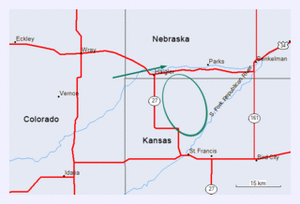
P
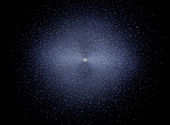
The
Oort Cloud, which envelops our solar system with perhaps trillions of
icy objects, extends to perhaps 5 trillion miles (50,000 astronomical
units) from the Sun.
urveyors of doom often look to the heavens for their protagonists. During the 1980s, we were briefly captivated by Nemesis,
a supposed companion of the Sun that triggered a death-dealing rain of
comets every 26 million years. During the 1990s we endured wild
speculations about Nibiru, which managed somehow not to destroy Earth in 2003.
Now there's a new threat - but unlike Nemesis and Nibiru, this one's
real. It's called Gliese 710 (pronounced GLEE-zuh), an obscure,
10th-magnitude orange dwarf star situated about 63 light-years away in
the constellation Serpens. Astronomers first took note of this modest
star about a decade ago, when Joan García-Sánchez (Jet Propulsion
Laboratory) and others found, based on positional observations from the
Hipparcos satellite, that in roughly 1½ million years Gliese 710 should pass about 1.3 light-years from the Sun.
That's not close enough for the gravitational pull of a 0.6-solar-mass
star to unhinge the planets from their current orbits. But it would stir up some trouble in the Oort Cloud,
the storehouse of perhaps a trillion comets that theoretically extends
to the limit of the Sun's gravitational grip. García-Sánchez and her
team estimated that 2.4 million Oort Cloud denizens might be perturbed
into Earth-crossing orbits over a couple million years, increasing the
risk of our planet being hit by a long-period comet by only 10%. No big
whoop.
But a revised Hipparcos catalog of stars' distances and motions came out in 2007, and a fresh analysis
of that and other datasets by Vadim V. Bobylev (Pulkovo Astronomical
Observatory) shows that Gliese 710 is a little more problematic than
first thought.
After running a million computer simulations that factored in
various observational errors, Bobylev confirms that the star has an 86%
chance of passing through the Oort Cloud's outer limit, assumed to be
1.6 light-years from the Sun. Moreover, the simulations yield a
1-in-10,000 chance of skirting within 0.02 light-year, or about 1,000
astronomical units. A star passing by only 50 times farther out than
Pluto would not only wreak havoc within the Oort Cloud but also do a
number on comets stashed in the Kuiper Belt.
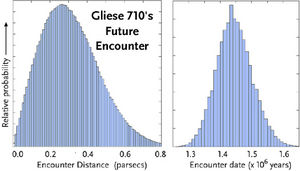
These
plots show the likely distance and timing of a future encounter with
the dwarf star Gliese 710. A parsec is 3.26 light-years.
Could
such a close encounter really happen? It probably already has.
Dynamicists point to the fact that the Kuiper Belt appears to end
abruptly at a distance of about 60 a.u. Then there's the strange
12,000-year orbit of 90377 Sedna,
whose solar distance ranges between 76 and 976 a.u. No mere planetary
encounter could have flung Sedna out that far; the only plausible
explanation is the gravitational yank from a close-passing star long
ago.
On the plus side, Bobylev's analysis of 35,000 stars within 100
light-years of the Sun didn't turn up any new interlopers of
consequence within the past or forthcoming 2 million years. He's added
nine new stars to the list of past or future encounters of 6½
light-years or less, none of which come nearly as close as Gliese 710.
Some 27 and 28 million years from now, respectively, the stars Proxima
and Alpha Centauri sail past our solar system but come no closer than 3
light-years.
Richard Todd
Fox19
Fri, 19 Mar 2010 03:43 EDT
Georgetown
- People in the eastern reaches of the Tri-state are trying to figure
out what the big noise was that they heard in the sky Thursday night.
Brown County dispatchers say they heard a booming sound their station
in Georgetown, and had calls from Mt. Orab in the northern part of the
county, and from Ripley and Aberdeen on the river. Some Mt. Orab
callers said it shook their homes.
Police in Hillsboro got seven calls shortly after 9 p.m. from
people saying they had heard a sound. One thought it might have been in
the neighborhood, but several other callers described it as a sonic
boom. A Hillsboro dispatcher who was in Highland County toward
Chillicothe saw a fighter jet that appeared to be in training dropping
flares as it crossed the sky, but she didn't notice any boom sound.
Bracken county dispatchers say they had a couple calls from
the east side of Augusta from people who said it shook their trailers.
The sound was also heard in Mason County in Kentucky.
Brown county called Wright Patterson Air Force Base,
but the base said they didn't know of anything that would have caused
the boom.
Police dispatchers in neighboring Adams, Clinton, and Clermont counties did not get any calls from the public.
Some viewers from Brown County who joined the FOX19.com internet chat Thursday night also heard the sound.
Television stations in Lexington and Columbus had not heard any reports of noises in their areas.
Marla Toncray
The Ledger Independent
Fri, 19 Mar 2010 21:00 EDT
Maysville, Kentucky - Concerned citizens reported hearing a loud boom
and feeling possible tremors to the Maysville Emergency 911 Dispatch
Center Thursday night.
Maysville Police Chief Kent Butcher and Maysville-Mason County
Emergency Management Director Jack Fultz said Thursday the reports of
the unusually loud boom, which apparently caused buildings to shake and
windows to rattle, started coming into the dispatch center around 9:25
p.m. Fultz said at one time, he was told about 50 calls came into the
911 center, most from Mason County, but some were from citizens in
Brown County.
Fultz said he felt the repercussions of the boom at his home,
located in western Mason County near Dover and he immediately checked
the National Geological Earthquake Web site, but there were no reports
of earthquake activity in the Ohio River Valley region.
During business hours Thursday, Fultz said he was told by
Larry Dixon, area manager for Kentucky Emergency Management Morehead
Office a similar incident occurred in Pendleton County earlier this
week, but the boom and subsequent aftershock were attributed to
activity at Black River Mine.
However, local emergency management personnel have
rolled up communications to the Kentucky Emergency Management Operation
Center in Frankfort, where officials from that office will check with
local industries and other sources to see if blasting has occurred or
what other activities may have caused the booms.
"I'm sure they are checking around with (local) people at this
time," Fultz said. Fultz also said when he receives information on what
occurred in the two areas, he would pass this along to the community.
Butcher said one caller reported a "loud sound in the sky" and a "ground shock" to 911 personnel.
Maysville-Mason County Emergency Management can be contacted at 606-564-2570.
Contact Marla Toncray at marla.toncray@lee.net or call 606-564-9091, ext. 275.
Richard Heath
Jersey Evening Post
Tue, 23 Mar 2010 14:56 EDT
Channel Islanders have been left baffled after what looked like a meteor flashed across the sky on Sunday night.
The fireball was first spotted in Guernsey before hurtling over the
east of Jersey seconds later. Residents in both islands reported that
the unidentified object was moving very quickly and very low across the
sky.
Patrick Devaney, a Guernsey teacher, said that he watched the
'meteor' shoot from Herm diagonally over St Peter Port and towards
Jersey.
Jersey Met Office confirmed that it received a report from an
Islander in Gorey of what appeared to be a meteor 'dashing very low and
very fast' across the sky at about 10 pm on Sunday. But Jersey's Air
Traffic Control department said that it had not detected anything on
its radar.
Vigilant sky watchers were treated to a fiery surprise in western Alabama sky on Friday, March 19.
Allsky meteor cameras at the Marshall Center and near Chickamauga, Ga.,
recorded a fireball streaking across the sky around 11:19 p.m. CDT.
Moving at a speed of 42,500 mph -- or 12 miles per second --
the meteor burned up approximately 20 miles up in the atmosphere.
Although very bright, the meteor was deemed not large enough to produce
meteorites.
Mid-March is typically a lull period for meteor shower
activity, but several bright fireballs have recently been spotted over
California, Mississippi and now Alabama.
Watch a short video clip of the meteor.
Wed, 24 Mar 2010 08:28 EDT
Daily Mail
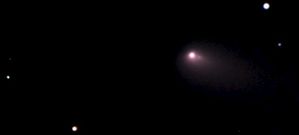
Caught
on camera: Siding Spring comet breaking up 100 million miles from
Earth. The chunk that can be seen behind the comet is said to be the
size of Mount Everest
An amateur stargazer has captured the moment a comet
exploded in space - an event missed by the world's professional
astronomers.
Musical instrument designer Nick Howes, 40, used the internet to access an online telescope as he sat at his desk in his office.
Mr Howes, of Cherhill near Calne, Wilts, logged on to a
telescope in Hawaii and began staring into deep space. But he spotted a
massive comet breaking up and was able to use the telescope to take
photos.
Nick, who works for Yamaha, actually captured the moment the
comet exploded, blowing a chunk the size of Mount Everest off one side.
He was the only person in the world to witness the dramatic
event - with even American astronomers completely missing the
opportunity.
The comet is known as Siding Spring after the Australian observatory where it was first spotted in 2007.

'Major
discovery': Nick Howes took pictures of the comet breaking up through a
remote-controlled telescope in Hawaii, run by Cardiff University
It is many times the size of Mount Everest and is
travelling at a speeds of around 19 miles a second - 20 times faster
than a bullet.
Nick's discovery has now been honoured by the International
Astronomical Union and hailed by experts as a 'major astronomical
discovery'.
Father-of-one Nick said: 'I had heard that a comet was passing
so I tried to view it myself and used a telescope in Hawaii to have
another look.
'But within about 10 minutes I spotted that it was blowing up.
It was amazing. I contacted the International Astronomical Union and
they confirmed I was the only one to make the discovery. I then made
lots of frantic phone calls.'
Nick took the images from his office in London using the Faulkes Telescope Project in Hawaii last Thursday.
He used the £5million telescope to capture six images that show a chunk
of ice known as a "dirty snowball" breaking away from the nucleus of
the comet.
The following day a second set of images showed the new
fragment is still trailing the comet, which is officially called C2007
C3. The online telescope project is run by experts at Cardiff
University who say they are 'delighted' with Nick's result.
Dr Paul Roche, of Cardiff University, said: 'What this
illustrates is what is achievable when amateur astronomers can get
their hands on such a powerful telescope.
'As the nucleus of a comet is typically tens of kilometres
across, this fragment is probably mountain-sized, and will become a
small comet as it gradually separates from its parent.
'We hope this discovery will help encourage others to use the Faulkes Telescopes and lead to even more scientific discoveries.'
Nick has a small observatory himself at his home and has since been tracking the comet's progress.
It was first spotted in October and is heading away from Earth and will never been seen again.
The comet was first spotted by Donna Burton - so perhaps should
have been called Donna's Comet or Burton's Comet. But it was instead
named after the Siding Spring Observatory near Coonabarabran, 280 miles
(500km) north-west of Sydney, Australia.
The Faulkes Telescope Project was launched in March 2004 as a
way of helping to inspire school students to study science and maths.
US: Huge bright green light falling over Southern New Jersey (fireball?)
Brian Vike
The Vike Factor (Into the Paranormal)
Wed, 24 Mar 2010 17:12 EDT
Posted: March 23, 2010
Date: March 23, 2010
Time: 3:05 a.m.
Location of Sighting: Southern New Jersey.
Number of witnesses: 2
Number of Objects: 1
Shape of Objects: Round.
Full Description of Event/Sighting: My
boyfriend and I were driving home on Broadway St in Pitman NJ (towards
Glassboro) and we saw a bright green light fall from the sky. We only
saw it for a few seconds before it disappeared behind trees. It came
down at a rough estimate of a 70 degree angle falling from right to
left. At first we thought it was a plane crashing, it was huge, but
nothing happened after it vanished behind the trees.
William P. Napier
The Cosmic Tusk
Sat, 20 Mar 2010 13:53 EDT
A Neolithic comet
(Appeared in an anthology: "God, the universe and men - Why do we
exist?" (ed. Wabbel, T.D.), Patmos, Dusseldorf, 2003 (original in
German).
Comets are jokers in the celestial pack. They irrupt, usually without
forewarning, into the orderly progression of the sky. They cross the
celestial sphere in weeks or months, growing one or more tails, before
fading and disappearing from sight. On rare occasions a comet may be an
awesome sight, and the historical literature of the past two thousand
years is sprinkled with accounts of the fear induced when a great
comet, its smoky red tail bisecting the heavens, appears in the night
sky. In the remote past, tales of such apparitions were often conflated
with stories of disaster on Earth. A comet called Typhon in Greek
mythology was connected with a mythological flood, and the legend of
Phaethon, in which the sun's chariot went off course and the Earth was
first burned up and then flooded, may describe an exceptional meteorite
impact. There is good evidence that the sky in Neolithic times was
dominated by a recurrent, giant comet, and that the Earth annually ran
through an associated meteor storm of huge intensity. The origin of
religion dates to these times and may be tied up with this spectacular
night sky. The prospect that cosmic myths, megaliths and art dating
from this time may have been responses on the ground to threats in the
sky has in recent years moved from Velikovskian fancy to a subject for
serious scholarly discussion. In more scientific times, too, it was
often suggested that a comet striking the Earth might create create
worldwide havoc. For example past encounters of Halley's comet were
supposed to have coincided with Noah's flood in 2342 BC.
This catastrophist view of Earth history was widely
held until late 1830s. From about the middle of the 19th century,
however, it was supplanted by a uniformitarian one, at least in the
English-speaking world. Partly this came about because geologists came
to recognise that the terrestrial landscape had been formed over aeons
by gradual forces, by erosion and slow mountain building. The
astronomers too played their part in this changing perception. Several
periodically returning comets were found to be associated with annual
meteor streams. It seemed that the end state of comets was nothing more
exciting than a swarm of dust. By the time of the Victorians, the
universe was seen as a more or less irrelevant backdrop to the affairs
of Earth. Scientists were free to explain evolution unhindered by any
thoughts of celestial disturbance. The occasional revivals of the
catastrophist worldview became the domain of cranks. This long slumber
lasted until the late 1970s.
The destroyer of worlds
Starting in the late 1970s, however, there came a renaissance
of catastrophism. A number of factors brought about this change of
perception. First, wide-angle telescopic surveys of the sky were
revealing the existence of a population of small, fast-moving
Earth-crossing asteroids, making impacts on Earth quite common events
on geological timescales. Second, large impact craters were being found
on Earth in increasing numbers. Usually these were overlain with
sediment or had otherwise gone unrecognised, being seen by Earth-minded
geologists as no more than, say, circular lakes. An example is Lake
Manicougan in Canada, 80 km across, about the size of the Copernicus
impact crater on the moon. The impact rates from both the evidence on
the ground and in the sky converged to the same picture: the Earth is a heavily bombarded planet.
From this new evidence it was not a large step to infer that the great
mass extinctions which populate the fossil record may have been caused
by celestial forces. After all, a 10 km comet or asteroid hitting the
Earth at 25 km per second would unleash 100 million megatons of energy,
equivalent to a small hydrogen bomb on each square km of the Earth's
surface. It is hard to believe that such an event would leave no
geological or biological trace! One killing mechanism might be the
ejection of dust, cutting out sunlight, decreasing photosynthesis and
so collapsing the food chain at its base. The heat generated by a large
impact, spread globally by incinerating debris, is another possible
killing mechanism: the world would be subjected to a rain of fire. It
is not surprising that many people (Urey in 1975, Napier & Clube in
1979, Alvarez in 1980), have over the years proposed that huge impacts
are connected with mass extinctions of life such as the dinosaur
extinctions of 65 million years ago.
Contrary to the popular literature, however, it is unlikely
that the 10 km bolides which generate the biggest craters on Earth are
asteroids. Asteroids in the belt between Mars and Jupiter are confined
to highly stable orbits. To be thrown out of the belt, an asteroid must
be nudged by collision from its stable orbit into a nearby, unstable
one.
This asteroid-nudging mechanism probably works for
kilometre-sized objects but a big asteroid is just too difficult to
shift. The major killers, then - the global destroyers - are likely to
be comets or their debris. But as soon as we look to comets as the
agents of mass extinction, we enter a whole new ballpark. And
overwhelmingly, the most massive objects to enter the near-Earth
environment on geologically interesting timescales are rare, giant
comets (say 100 - 200 km or more across).
It is very unlikely that such a monster has struck the Earth
any time within the past billion years, if only because it would have
sterilised the planet. The fate of a short-period comet approaching the
sun is to disintegrate. The dust generated by a very large comet will
form a temporary disc around the sun, within which the Earth will
orbit. We are immersed in such a disc, the zodiacal cloud, now. However
in the wake of disintegration of a giant comet the mass of this
zodiacal cloud will increase to hundreds or thousands of times its
present mass. Immersed in it will be larger debris, ranging from cm
sized icy pebbles to multi-km fragments of the original comet. The
result is that for a period of tens of thousands of years following the
arrival of a supercomet, the Earth environment becomes extremely
hazardous. Small dust particles may trickle down for the active
lifetime of rare, giant comets - which could be millennia. The
resultant cooling may lower the ocean levels by some hundreds of
metres, changing the spin rate of the Earth and inducing stresses at
the core-mantle interface comparable to those involved in plate
tectonic movement. Rapid
climatic variations, coupled probably with worldwide tectonic
disturbances, are then expected. A cosmic mass extinction is, then, a
much more complicated affair than a single huge impact. Rather, it is
an affair of multiple impacts coupled perhaps with extensive
vulcanisms, lava outpourings and rapid climatic changes.
As it happens, this more complex picture gives a much better fit to the
detailed record of events at the well studied extinction boundaries, in
particular the stepwise extinctions and severe coolings of the Earth 36
- 39 million years ago, and the dinosaur extinctions of 65 million
years ago, which were preceded by a rapid greenhouse warming over
200,000 years followed by a cooling during the last 300,000 years,
accompanied by a massive outpouring of lava in India over the same
period and the deposition of several layers of small glass spherules in
Mexico, the Indian Ocean and other places, indicating, probably, a
multiplicity of impacts. Extinctions of many life forms such as
bivalves, ammonites and rudists were well under way long before the big
impact which gave the 170 km Chicxulub crater of 65 million years ago.
The Galactic connection
The arrival of comets, too, gives structure to the terrestrial
record of catastrophes. Many comets derive from the Oort cloud, a great
swarm comprising maybe 100 billion comets or orbiting at distances out
to 50,000 astronomical units, a quarter of the way to the nearest star.
Comets orbiting beyond this distance would be thrown into interstellar
space by the gravitational action of passing stars and nebulae. The sun
has a tenuous gravitational hold on the Oort cloud comets, and it is
not surprising that the Oort cloud is sensitive to the galactic
environment. It is is disturbed from time to time, by passing stars, by
massive nebulae or when the solar system penetrates the spiral arms of
the Galaxy - for our Galaxy is an open-armed spiral. Any such disturbance sends a swarm of comets plunging into the inner planetary system, and with luck we might be able to see the effects of spiral arm penetrations or passing nebulae in the geological record.
In fact, when we examine the age distribution of the well-dated
terrestrial impact craters, of which there are less than fifty, a
remarkable pattern emerges. There's a distinct bunching of ages, with
clearly identifiable impact episodes (seven in the last 250 million
years). Most of the larger craters belong to these impact episodes.
There seems to be a background 'drizzle' of small impacts - probably
strays from the asteroid belt - superimposed on which are powerful
bombardment episodes each comprising a swarm of missiles, including
major impactors yielding collisions 50 - 100 million megatons in
energy. Bombardment episodes of this sort may be expected to yield mass
extinctions of life and corresponding geological disturbances and
indeed a correlation, albeit a very imperfect one, does exist.
Remarkably, the two greatest mass extinctions coincide with
passages of the solar system through the spiral arms of the Galaxy. The
closest life came to extinction in post-Cambrian times seems to have
been the Permo-Triassic event of 245 million years ago, when perhaps
95% of all species became extinct. At that time the solar system was
passing through a spiral arm known as the Scutum arm. And about 60 - 70
million years ago, covering the epoch of the Cretaceous-Tertiary mass
extinction, the solar system was passing through the Sagittarius arm.
Without this passage, the dinosaurs might still be with us and homo
sapiens would probably not exist: we are children of the Galaxy.
And yet, life has survived, and seems to have existed on
Earth, no doubt surviving many impacts and other cosmic disturbances,
for a very long time. The evidence for Precambrian life is strong, and
was reported as long ago as 1858, not long after the publication of The Origin of Species.
The strongest evidence for this comes from stromatolite domes -
precipitates from the metabolic activities of sea-floor microorganisms
- which have been found in rocks 3,500 million years old in Western
Australia.
Earlier than that, we enter the era of the so-called Late
Heavy Bombardment. This was a time, comprising the first 10% of Earth
history, when the impact rate was perhaps a thousand times higher than
it is at the present time: the heavily cratered lunar highlands belong
to this era. The heat generated from large impacts, in those days,
would have repeatedly raised the temperature of the crust to above 100
degrees Centigrade and so sterilised the Earth. Probably, oceans could
not exist because they would simply boil off. Whatever the cause of
this tremendous bombardment, it seems to have come to an abrupt end
about 3.8 billion years ago. It is striking that life is found on the
Earth just as soon as this bombardment subsided.
Without Jupiter and Saturn, comets flooding in from the Oort
cloud would subject the Earth to a sustained bombardment comparable to
that of the early Earth. But these giant planets act as powerful
shields, gravitationally deflecting the long-period comets away from
the inner planetary system. We owe our existence to Jupiter and Saturn.
This does raise an interesting constraint on the existence of
carbon-based lifeforms in other star systems: a sheltered environment
is essential. The argument is quite general and depends only on the
kinetic energies and impact frequencies of small bodies which,
presumably, are a universal accompaniment to planetary systems. We do
not know enough about other planetary systems to say how common such
environments are likely to be. It is one more ingredient to be thrown
into the anthropic pot.
The evidence of the terrestrial record, then, is that life has
an ability to withstand cosmic slings and arrows throughout aeons,
provided these impacts are not so energetic that they sterilise the
planet. This must come down to life's powers of replication. A single
microorganism with a doubling time of one hour, surviving a great
cosmic disaster, would replenish a nutrient-rich ocean within a year.
A mechanism for interstellar panspermia
This power to replicate has led to speculation that, perhaps, life is a cosmic rather than simply a terrestrial phenomenon,
drifting throughout the Galaxy and taking root where it can. If this
were so, it would profoundly affected our perceptions of life's cosmic
significance. But we need a mechanism for interstellar panspermia. And
here, unexpectedly, giant comets seem to provide it.
It has long been clear that a large impact may eject materials
from a planet. The streaks from the crater Tycho, easily seen with
binoculars, cover the entire lunar hemisphere and are evidence that
material can be thrown thousands of kilometres from an impact site. A
large, fast impact on land on the Earth will throw a mass of
terrestrial rock equal to a fraction of a percent of the impactor mass
into orbit around the sun. Most of this material will be quickly
recaptured by the Earth, some will eventually fall into the sun, but a
small proportion, subject to the bagatelle of random planetary
perturbations, will eventually be ejected from the solar system
altogether. It is estimated that something like 10 tonnes of surface
material from the Earth, from past terrestrial impacts, drifts into
interstellar space each year. A gram of poor, rocky soil may contain 10
million microbes, and microorganisms will occupy every micro-crack in a
boulder. Shielded from ultraviolet light, it is likely that
microorganisms could survive for, say, a hundred thousand years before
cosmic rays eventually destroy them. This figure may be conservative:
survival times of 100 million years against cosmic rays have been
proposed.
Here, however, we have a problem. In the form of a handful of
boulders, such ejecta would simply lose themselves in interstellar
space. It is unlikely that any life-bearing boulder from Earth has ever
landed on another planet: the distances to be covered are simply too
vast.
But the situation changes radically if, when life-bearing
boulders are thrown out of the Earth, they are then eroded into
sub-microscopic particles. A particle a few microns in diameter is
rapidly thrown out of the solar system by the pressure of sunlight.
Fast erosion occurs when a giant comet is thrown into a short-period,
Earth-crossing orbit. In that case the mass of the zodiacal cloud is
enhanced by two or three powers of ten. A metre-sized boulder, struck
at 15 km/sec by the cometary dust particles, may be reduced to
micron-sized particles within a decade. Such comets are thrown into
suitable orbits every 100,000 years or so and so the process is not
uncommon.
The result of this rapid erosion is, not a handful of bodies,
but perhaps 1018 particles thrown each year into interstellar space.
The Earth becomes surrounded by an expanding biosphere several light
years across, containing a vast number of life-bearing dust particles.
The solar system passes through or close to star-forming
nebulae occur every 100 million years or so, and these life-bearing
particles will be injected directly into protoplanetary systems. In
this way, provided that systems with the capacity to support life are
generated in the star-formation process, then the necessary codes for
replication will already be present. Suppose that we started with a
Galaxy in which planets receptive to life are common, but on which life
had not taken hold. Then with an initial seeding from the Earth alone,
the whole galactic disc would become life-bearing within a few billion
years. Life would spread like a chain reaction in a nuclear explosion.
Just as the notion of comets as destroyers of worlds is very
old, so also is the notion of them as creators. In 1790, Sir William
Herschel was presenting a world view in which comets moved from one
star-system to another, replenishing life as they went. There's nothing
new under the sun!
And so it turns out that these rare, large, icy bodies - giant
comets - have much more significance for life than we might have
expected. One of them may have had a profound effect on the way our
ancestors perceived the world around them. They may have been a major
factor in the evolution of life on our planet. And they may also have
played a vital role in the spread of life throughout our Galaxy.
Robert Roy Britt
Space.com
Thu, 25 Mar 2010 14:43 EDT
When you think big, as Richard A. Muller does, you're
"The trouble with most folks isn't so much their ignorance. It's know'n
so many things that ain't so." - A favorite quote of Richard A. Muller,
by 19th century humorist Josh Billings.
bound to create ideas now and then that are so compelling you just
can't let go of them -- ideas so outlandish that mainstream scientists
are equally eager to dismiss them.
Muller, a physicist at University of California at Berkeley, has had his share of big ideas.
If you don't count the restaurant he owned between 1976 and
1982 ("If anyone near and dear to you wants to open a restaurant, I can
now be hired to talk them out of it."), Muller's ideas are generally
rooted in solid science and genius extrapolation. He's got a gaggle of
prestigious awards to prove it, with titles that say things like
"outstanding" and "highly original."
But Muller's biggest idea is a real Nemesis. Or so he claims.
Like a thorn in the side of mainstream researchers, Muller's Nemesis
theory -- that our Sun has a companion star responsible for recurring
episodes of wholesale death and destruction here on Earth -- seems to
reemerge periodically like microbes after a mass extinction.
It's a theory that has many detractors. And it's a theory that
has been beaten down and left for dead in the minds of most scientists.
Yet it is a theory that just won't die.
Nemesis is cautiously supported by a handful of scientists, who
often sound like ringside rooters eager for a victory but thankful they
don't have to put the gloves on. Muller meanwhile acknowledges the
possibility that the whole idea could turn out to be wrong, but he is nonetheless confident that Nemesis will be found within 10 years.
"Give me a million dollars and I'll find it," Muller said in a recent telephone interview.
Brave words for a bold theory that if proven true would shake up
everything we know about the formation and evolution of our solar
system.
Genesis of Nemesis
Muller's idea for Nemesis came to him 1983. Luis Alvarez, then
an emeritus professor of physics at the University of California at
Berkeley, and his son Walter had recently put forth the theory that a
giant impact had wiped out the dinosaurs. (This idea, like so many
others that are now widely accepted, met with staunch criticism when it
was introduced because it, too, was not mainstream).
Around the same time, two other researchers had suggested yet
another controversial idea, that mass extinctions occurred at regular
intervals -- every 26 million years or so. Scientists immediately
folded the ideas into a new and breathtaking possibility: Impacts by
space rocks were causing massive global species destruction every 26
million years.
Luis Alvarez was Richard Muller's mentor, and he suggested
that Muller try to debunk the periodicity argument. Pondering this,
Muller dreamed up the fanciful companion to the Sun as a possible
cause, and with Berkeley's Piet Hut and Marc Davis of Princeton, worked
out the details.
Muller gave the object the name of the Greek goddess of
retribution -- fitting for a killer star that roamed stealthily beyond
the solar system flicking comets at dinosaurs.
In the end, the idea looked surprisingly plausible to Muller
and his colleagues, and the results of their work were ultimately
published in the journal Nature
in 1984. Muller then wrote a book about Nemesis, and he has pursued the
companion star, while also doing other research, ever since.
Tossing comets at us
Nemesis, as Muller sees it, is a common red dwarf star that
would be visible through binoculars or a small telescope, if only we
knew which of some 3,000 stars to look at. These are stars that have
been cataloged, but their distances are not known.
Any one of them could be the Death Star, as Nemesis has come to be called by some.
Red dwarfs are the most common stars in the galaxy. They are
small and relatively cool, dimmer than our Sun. The notion of companion
stars is also exceedingly common -- more than half of all stars are
part of such a binary system, in which two stars are thought to form
out of a single cloud of gas and dust.
Binary stars settle into a gravitational dance around a common
point in space. The smaller of the two stars does most of the orbiting,
whereas the larger one is much closer to the center of the dance
routine. It's like two kids on a seesaw. For the thing to work
properly, the heavier child must sit closer to the center of the
apparatus.
Muller figures Nemesis' orbit ranges from 1 to 3 light-years away from the Sun.
On its closest approach, the lethal companion would pass
through a vast, but sparsely populated halo of primitive comets called
the Oort Cloud, which surrounds our solar system from beyond Neptune's
orbit out to nearly a light-year away. (The Sun's nearest known star,
Proxima Centauri, is about 4.25 light-years away).
During this passage through or near the Oort Cloud, the
gravity of Nemesis would scatter a furious storm of primordial comets
that had been relatively undisturbed for 4.5 billion years, since the
solar system came into being.
Dislodged from their once-stable orbits, millions or billions
of these comets would travel to the inner solar system over millions of
years, pulled toward the Sun by its gravity. A handful would run into
Earth along the way, and the flurry of impacts would result in mass
extinctions.
Simple enough. But Nemesis has for years been dogged by a
misunderstanding, Muller says. Most researchers think the theory was
long ago dismissed by competing data that claimed its orbit was not
possible.
Far-out idea
The orbit assumed for Nemesis is an unusual one, Muller admits.
No star has ever been found to orbit so far from a companion. "And that
really bothers people," he said. "It makes them think that this is a
really far-out idea, literally."
But computer models developed by Muller and his colleagues
predict that such an orbit must occur at some point in the evolution of
most binary star systems. "We just haven't found such systems yet," he
said.
And while Muller appreciates the natural and healthy
skepticism of other scientists, he figures they are not interested in
funding a search because they erroneously assume that Nemesis cannot be
found.
Jonathan Tate is the director of Spaceguard U.K., which
lobbies for a government response to the threat of asteroids. Tate is
among those who see no rush to find Nemesis. He would rather see money
spent on more immediate searches for asteroids closer to Earth that
might prove to be humanity's undoing in coming decades or centuries.
As Tate points out, proving that mass extinctions occur every
26 million years, regardless of the cause, is only of academic
interest: Humans may not likely be around to care, as many researchers
don't expect our species to last that long. If we do survive, there
will likely be plenty of time to worry.
Questioning periodicity
Meanwhile, many scientists see little or no credibility to the
studies alleging periodicity in mass extinctions, and hence no need for
a Nemesis theory.
Numerous studies have reported cycles in either impacts or
mass extinctions. The period between peaks in these studies mostly
range from 26 million to 35 million years. Andrew Glikson of the
Australian National University says that trying to pin down things that
happened so long ago is no simple challenge. For one thing, space rocks
that land in the ocean leave few clues, Glikson points out, and Earth
is roughly two-thirds water.
And Earth has always had a crust that is on the move. Evidence
gets buried, destroyed, and folded into oblivion by the same process
that creates mountains and moves continents.
"Some of the suggested periodicities are more likely to represent statistical artifacts than robust observations," Glikson said.
David Raup, a University of Chicago paleontologist, made the
original mass-extinction periodicity argument two decades ago along
with colleague J. John Sepkoski. The pair studied marine fossil records
over a 250 million-year period that they say showed significant spikes
every 26 million years.
"To me, the periodicity idea is as well supported as many
ideas that have been adopted into the conventional wisdom, but the
scientific community is heartily skeptical," Raup told SPACE.com. "Of
the 15 or so re-analyses of our data published since the original
paper, about half support periodicity and half reject it. It's is still
very much in the eye of the beholder."
Muller supports the statistics more emphatically.
"There is a peculiar pattern in mass extinctions, something
that cannot be dismissed as a statistical fluctuation," Muller said.
"It requires some explanation."
Raup, now retired from active research, would not venture a
guess as to when or whether Nemesis might be found, but he expressed
hope in the idea: "I am glad Rich [Muller] is still working on it
because it may take a lot of effort, and he's the best."
The galactic plane, Planet X and black holes
Other ideas have been put forth to explain the alleged periodicity in mass extinctions.
The most widely accepted is the suggestion that the solar
system, as it revolves around the center of the Milky Way, bobs up and
down through the plane of the galaxy. This plane is full of gas and
dust that never became stars, which collectively has a certain amount
of gravity that some expect might dislodge comets from the Oort Cloud.
There are doubts, however, about the amount of mass in the
galactic plane and whether or not the timing coincides with the
periodicity of mass extinctions.
Others have suggested a dim failed star known as a brown dwarf
might be lurking in the distant fringes of the solar system. Muller
called the increasing rate of discovery of brown dwarfs, including one
that is just 13 light-years away, "extremely discouraging." For if Nemesis were a brown dwarf, it would be harder to find.
Yet another enduring idea is that another large planet lurks beyond
Pluto. This so-called Planet X would be a gas ball up to five times the
size of Earth, according to some predictions. Even the possibility of a
black hole has been raised. Few researchers support these two ideas.
Evidence from the Moon
The best evidence for periodic impacts on Earth may ultimately
come from the Moon. While the Earth's crust has been stretched,
squashed and folded violently its whole life, the Moon is relatively
static, preserving a far more accessible geologic record.
A year ago Muller, Berkeley geologist Paul Renne and
then-graduate student Timothy Culler found the Moon underwent a flurry
of impacts between 400 million and 600 million years ago. The active
period (which may still be going on) presumably affected Earth as well
since both bodies are in roughly the same spot in the solar system.
Muller says the sudden increase offers indirect evidence for a
sudden change in the orbit of Nemesis, which might have been caused by
a passing star.
But the study did not turn up evidence for the 26 million-year
periodicity, as hoped. Muller says there was not enough data. The study
involved 155 microscopic glass beads formed in the intense heat of
lunar impacts and later brought to Earth, in a single gram of soil, by
the Apollo 14 crew.
But given that there are "several hundred pounds (kilograms)
of [lunar] dust and rocks that have not been analyzed," Muller plans
another more detailed study.
Whether or not he finds evidence for Nemesis in Moon dust,
it's clear that Muller won't stop looking. He is a man of enduring
confidence. But he is also a remarkably conservative scientist, quick
as anyone to point out that there is no proof until there is proof.
"I'm realistic," he said. "I may be wrong."
And he recognizes that if the Death Star is not found, the
whole idea could become a real Nemesis for the big thinker who dreamed
it up.
On March 19th at 11:19 Central Time, a meteoroid entered Earth's
atmosphere over the southeastern United States and disintegrated in a
flash as bright as the crescent Moon. To the human eye, it appeared to
be a garden-variety fireball, the kind that appears almost every clear
night, but NASA cameras had a different story to tell.
"This
was an unusually low-flying meteor," says Bill Cooke of NASA's
Meteoroid Environment Office. Cooke and colleagues operate a pair of
all-sky cameras, one in Huntsville, Alabama, and another in
Chickamauga, Georgia. Both cameras caught the fireball, allowing rapid
triangulation of its flight path. "It was first recorded at an altitude
of 72.9 km (45.3 miles) and burned up at an altitude of 32.5 km (20.2
miles)."
That's low. Most meteoroids disintegrate around 70 to 80 km
high. This one held together for a much deeper descent. "It had a lot
of structural integrity. Maybe it was a metallic object," speculates
Cooke. "Based on the brightness and velocity of the fireball, I
estimate a mass of about 10 kilograms and a diameter of ~20 centimeters
- a decent size!"
Cooke's meteor mini-network is "smart." When both
cameras catch a fireball, the system's software springs into action and
immediately calculates a flight path and orbit for the meteoroid. Cooke
receives an email alerting him to interesting events that might
otherwise have gone unnoticed. "In the near future, we plan to expand
our network along the eastern seaboard of the United States," notes
Cooke. "With smart cameras on duty, who knows what we might find?" Stay tuned for the unexpected.
Mark Bushnell
Time Argus.com
Sun, 28 Mar 2010 03:30 EDT

The
corner of Church and College streets in Burlington was the site of a
mysterious incident in 1907 in which people reported seeing a ball of
fire that dropped toward the ground and exploded. It was followed by a
downpour. Here is a rendering of how it might have appeared.
It
is a bolt out of the blue. Just a typical day - nothing seems unusual
in the moments before the giant blast strikes Burlington. It is shortly
before noon on July 2, 1907, a Tuesday.
Nobody bothered to record the mundane details of that day, but
we can imagine the scene downtown: people ducking into and out of
stores; others working at their office desks; some walking home for an
early lunch. This being summer, children are playing on the sidewalks
and streets. Much, probably most, of the traffic is horse-drawn. Few
cars yet rattle through Burlington's streets.
In the midst of this imagined scene, we know exactly where
some people are. There is John Stephen Michaud, the bishop of
Burlington, and former Vermont Gov. Urban Woodbury, chatting at the
corner of Church and College streets. Alvaro Adsit can be seen through
the window of Ferguson and Adsit's Store, the grocery he co-owns on the
corner of College and Mechanic streets. W.P. Dodds is in his office at
the Equitable Life Insurance Co. on College Street.
Then, things get weird in a hurry. A bright ball of light catches Dodds' eye. It is in the sky to the northwest and descending.
Adsit sees it, too. Looking out his store window, he sees a "fire ball" drop in front of a nearby furniture store.
When the ball is about 15 feet above the street - Boom! - it explodes.
People rush into the street to see what has happened. They find a horse
lying lifeless in the road in front of the Standard Coal and Ice Co.
But moments later, it stirs and gets back on its feet.
People cluster and talk excitedly about what happened and
share what they have seen. A young man working at the Strong Theater, a
block away on Main Street, says he saw the fireball. Another
unidentified man says he saw the ball strike College Street, knock over
the horse with its blast, then shoot back into the sky.
The next day, the Burlington Free Press reports the incident
to readers, suggesting that lightning had been the cause of the boom.
The paper writes:
"A forerunner to one of the heavy and frequentThe reporter, who interviewed the ex-governor, writes:
thunderstorms that have characterized the early summer in this vicinity
startled Burlingtonians yesterday just before noon. Without any
preliminary disturbance of the atmosphere, there was a sharp report,
the like of which is seldom heard. It was much louder in the business
portion of the city than elsewhere, and particularly in the vicinity of
Church and College Streets. People rushed to the street or to windows
to learn what had happened ..."
"Governor Woodbury said his first thought was that an explosion had
occurred somewhere in the immediate vicinity, and he turned, expecting
to see bricks flying thru the air."
The writer gives less credence to the unnamed witness who
reported seeing the fireball bouncing on College Street, calling him a
"man with a vivid imagination."
"The unusual disturbance," the reporter concludes his article,
"was followed in a few minutes by a downpour of rain, which continued,
with brief interruption, for nearly two hours."
That might have been the end of the story, if not for the
claims of Bishop Michaud, who was the witness with either the best
visual acuity or the most active imagination. Michaud's detailed
account of events has made the incident live on. It doesn't show up so
much in the pages of conventional history books, but in the pages and
Web sites of believers in UFOs. Given Michaud's elaborate narrative of
things (which no one else apparently saw), it is easy to see why the
Burlington incident has drawn curiosity.
A month after the event, Burlington's weather forecaster
William H. Alexander wrote a report that appeared in the national
Monthly Weather Review. Alexander, who interviewed witnesses, quoted
Michaud at length.
The bishop explained that he was talking with Gov. Woodbury
and a Burlington businessman "when, without the slightest indication or
warning we were startled by what sounded like a most unusual explosion,
evidently very near by."
What was more unusual was what he said he saw next:
"Raising my eyes and looking eastward along College Street,The object at first was still, but then it began to move
I observed a torpedo-shaped body some 300 feet away, stationary in
appearance and suspended in the air about 50 feet above the tops of the
buildings. In size it was about six feet long by eight inches in
diameter, the shell cover having a dark appearance, with here and there
tongues of fire issuing from spots on the surface resembling red-hot
unburnished copper."
slowly over a nearby store. "As it moved," Michaud said, "the covering
seemed (to be) rupturing in places and through these the intensely red
flames issued."
The bishop's first thought was that he had seen an "explosive
shot" from the upper part of the Hall Furniture Store, which stood on
College Street. The object was encircled by a dim halo of light about
20 feet in diameter. An "angry-looking cumulonimbus cloud approaching
from the northwest" was the only sign of bad weather, according to
Michaud. He said a downpour erupted, but it came about 20 minutes after
the blast and lasted perhaps 30 minutes or more, which is a longer
delay and shorter storm than the Free Press had reported.
The bishop was shaken by the event. "Four weeks have passed
since the occurrence of this event, but the picture of that scene and
the terrific concussion caused by it, are vividly before me, while the
crashing sound still rings in my ears," he told Alexander. "I hope I
may never hear or see a similar phenomenon, at least at such 'close
range.'"
Though Alexander quoted Michaud extensively in his article, he
doesn't seem to have given much credence to his claims. Instead,
Alexander looked for a known phenomenon to explain the incident. "The
most prominent feature (of recent weather in Vermont)" he informed his
readers, "was the large number of violent, and in many cases
destructive, thunderstorms that occurred."
What was distinctive about the storm in Burlington on July 2,
he wrote, was the "single peal of thunder or explosion attended by what
is believed to have been a case of 'ball' or 'globe' lightning."
David Ludlum, a Vermont weather historian, came to the same
conclusion in writing "The Vermont Weather Book" in 1985. He explained
that ball lightning "is a relatively rare form of lightning, consisting
of a reddish, luminous ball, of the order of one foot in diameter,
which may move rapidly along solid objects or remain floating in
mid-air."
Even if Burlington's big bang was caused by ball lightning,
that doesn't strip all the mystery from the incident. Ball lightning is
still not completely understood, says Chris Bouchard, a meteorologist
at the Fairbanks Museum in St. Johnsbury, who agrees such lightning is
the most likely explanation of the episode in 1907.
"We don't have a satisfactory explanation of how it forms,"
says Bouchard, "but it has been seen by enough people over the years
that it is generally believed to exist."
Though Bouchard hasn't witnessed ball lightning, he has friends and family members who have.
The meteorologists at the Fairbanks Museum got a call a couple
of years ago from someone who had been driving on Interstate 91 near
St. Johnsbury when a large luminescent ball of light, perhaps 6 feet in
diameter, appeared right in front of the car. The driver couldn't avoid
the ball, which disappeared in a flash as the car drove through it.
A strange and interesting incident. Too bad a bishop or former governor wasn't there to witness it.
Mark Bushnell's column on Vermont history is a regular feature in
Vermont Sunday Magazine. A collection of his columns was published in
the book "It Happened in Vermont." He can be reached at
vermontpastlane@gmail.com.
Elisabeth Mittelb
Space Daily
Sun, 28 Mar 2010 22:49 EDT

The
office at DLR Berlin, number 321, is the hub of all the activities of
Dr Alan Harris. It is here that the threads of his largely
international research work into comets and asteroids all come together.
"Surprise!"
- Alan Harris loves this word. It really suits the character and
profession of this 58-year old British scientist. With a Doctorate in
Physics, this 'Senior Scientist' at the German Aerospace Center's
Berlin-based Institute of Planetary Research (Institut fur
Planetenforschung) works in the 'Asteroids and Comets' department. As a
scientist, he knows that his research will always lead him to surprises
and questions.
"I'll find that out at a later date - right now it's still
unknown to me," he says with a grin. Even after 30 years of
professional experience, Dr Harris believes that the ability to remain
inquisitive and to be positively motivated about things is as important
to a researcher as luck and good fortune.
Born in the industrial city of Birmingham, he has had an
interest in astronomy since his earliest years: "Even as a child, I
took an interest in the stars, and especially in watching the night
sky. I kept on asking myself the same questions: what are they, where
do they come from, and what do they mean? My mother was unable to
answer these questions for me, so I derived most of my knowledge from
books," says the man with the lively brown eyes.
The origins of asteroids and comets
Finding out how our Cosmos evolved billions of years ago, the role that
planets, stars and other heavenly bodies have to play in our Solar
System, where asteroids and comets come from and why their impacts have
such devastating consequences - these are topics that never leave the
mind of this eminent DLR scientist - and that includes the question of
when the Earth will be struck by an asteroid next.
"This is something that could happen tomorrow, or just as
easily, not for 100,000 years," says the astrophysicist. "Collisions
are a natural process in our Solar System. Without it, there would be
no planets, and also no life on Earth."
Alan Harris views comets and asteroids as a means of
transport, also for the materials essential for life. "Without them, we
cannot understand the origins and development of planets," he explains.
Comets are of such great interest to astronomers because they
are about 4.6 billion years old - meaning that they carry within them a
portion of the 'original material' of outer space. Scientists hope to
learn something about the origin of life from these lumps of rock and
frozen gases.
In most cases, asteroids are the debris of collisions between
larger bodies or the remnants of a burnt-out comet. In the course of
their development from a grain of dust to a planet, they have somehow
'got stuck in a rut'. Some have a diameter of several hundred
kilometres, while others are no larger than a pebble.
Collisions with Earth millions of years ago
The planets in our Solar System move on steady orbits around
the Sun. This means that scientists like Alan Harris can calculate
their behaviour precisely. In theory, the same is also true of comets
and asteroids. The difference is that they are relatively small and
light, and they can also be sent off course by a range of different
forces - for example, the gravitational pull exerted by other heavenly
bodies. This is when things start getting dangerous.
"In the course of its history, the Earth has often been struck
by asteroids and comets, but the last collisions with global effects
took place millions of years ago," says Alan Harris. For example, about
15 million years ago a double asteroid struck what is now the
Nordlinger Ries region of Bavaria and the Steinheimer Becken of
Baden-Wurttemberg, leaving craters roughly 25 and 3 kilometres in
diameter respectively.
"This was clearly an asteroid with a diameter of roughly one
kilometre, and it even had its own moon. This object struck the Earth
at a staggering 15 kilometres a second," he added. An impact of this
magnitude unleashes unimaginable levels of kinetic energy.
"That is a great deal worse than a volcanic eruption or an
earthquake, and has global implications. However, since we have no
specific experience with asteroid collision impacts, all we can do is
model them. In other words, use the laws of physics and mathematics to
conduct research into the lasting effects of an asteroid impact on
Earth.
Coming to grips with the risk of an asteroid impact
Astrophysicist Harris admits that an event of this kind, while
a very real possibility, is nonetheless a very rare occurrence. He also
admits that a high proportion of his daily work deals less with defence
against asteroid impacts than with research into their physical
properties - that is, their form, density, structure and surface
properties - as well as their history.
"These are insights which further the cause of basic research
into the Solar System, but which are also important in terms of
potential protective measures and which enable us to get a handle on
the risk of a collision's impact," summarises our DLR researcher.
The focus of his attention are 'near-Earth' asteroids. "We are
familiar with about 90 percent of the larger ones in this category, but
there are also a great many smaller ones, some of them concealed,
meaning that we cannot observe them."
So what was it that brought 'asteroid hunter' Alan Harris to
DLR? After obtaining his high school leaving certificate, he was off to
the University of Leeds to study physics and then went on to study for
a Doctorate in Astronomy. "Back then, we built a telescope capable of
receiving infrared radiation from a very high-altitude balloon
gondola," he reminisces.
In 1977, Harris obtained his doctorate in infrared astronomy
and moved to the Max-Planck Institute for Astronomy in Heidelberg for
postdoctoral research. A spell at the Astronomy Centre of the European
Space Agency (now ESAC) in Madrid followed, after which he returned to
the UK in 1986 and worked as an astrophysicist at the
Rutherford-Appleton Laboratory, not far from Oxford.
In 1989, he moved to the Max-Planck Institute for
Extra-terrestrial Physics in Garching, where he came into contact with
DLR's planetary researchers, who were still based in the town of
Oberpfaffenhofen, near Munich, at that time.
Deeply committed to the exchange of ideas with young scientists
With the reunification of Germany, the Institute was relocated
to Berlin and Harris moved there too, with his wife and daughter. Since
July 1993, his desk has stood in Office 321 of the DLR premises in
Berlin-Adlershof. This is where the scientific papers and books pile
up, the PC is always running, and where photos and posters record
highlights of the last 30 years of astrophysics and planetary research.
Harris is also deeply committed to sharing his knowledge with
new talent in his field. He regularly assists doctoral students, and
often has lunch with them to discuss their work. His calendar has a
number of permanent fixtures and, alongside numerous international
events and conferences, he makes it a point to attend the Asteroids,
Comets, Meteors (ACM) conference convened every three years by the
International Astronomical Union.
At the 1999 ACM in Ithaca, in the US state of New York, the
astrophysicist was awarded the industry's equivalent of a knighthood:
Asteroid '(7737) Sirrah' - 'Harris' spelled backwards - was named after
him.
The name 'Harris' was already taken because Alan Harris, the
DLR scientist has - and what a surprise this is - a colleague with the
same name in the USA, also an astrophysicist with his name given to an
asteroid. Then again, this DLR researcher has no problem coping with
combinations of that kind. After all, he is accustomed to reaching for
the stars.
Imagine
you're a Brontosaurus with your face in a prehistoric tree top,
munching on fresh leaves. Your relatives have ruled planet Earth for
more than 150 million years. Huge and strong, you feel invincible.
You're not.
Fast forward about 65 million years. A creature much smaller
and weaker dominates the Earth now, with brains instead of brawn. Its
brain is a lot larger than yours relative to its body size - plenty big
enough to conceive a way to scan the cosmos for objects like the
colossal asteroid that wrought the end of your kind.
The creature designed and built WISE, NASA's Wide-field
Infrared Survey Explorer, to search for "dark" objects in space like
brown dwarf stars, vast dust clouds, and your nemesis - asteroids. WISE
finds them by sensing their heat in the form of infrared light most
other telescopes can't pick up.
"Our instrument is finding hundreds of asteroids every
day that were never detected before," says Ned Wright, principal
investigator for WISE and a physicist at the University of California
in Los Angeles. "WISE is very good at this kind of work."
Visible-light telescopes conducting past asteroid surveys may
have missed a large population of darker asteroids that WISE is now
flushing out of hiding. Most of the asteroids WISE is finding are in
the main asteroid belt between Mars and Jupiter, but a fraction of them
are different - they're the kind of Earth-approaching asteroids that
send shivers all the way down a Brontosaurus' spine.
"WISE has only been in orbit for about three months, but we've
already found a handful of asteroids classified as 'potentially
hazardous,' including one seen in 1996 but lost until
re-observed by WISE. To be named 'potentially hazardous,' an asteroid
has to pass within about 5 million miles of Earth's orbit. One of our
discoveries will cross Earth's orbit less than 700,000 miles away."

Above:
This blink comparison shows why infrared wavelengths are so good for
asteroid hunting. It's a patch of sky in the constellation Taurus
photographed at two different times by the infrared Spitzer Space
Telescope. The two frames are correctly aligned; the objects are moving
because they are asteroids. At thermal infrared wavelengths, most of
the bright objects in the plane of the solar system are space rocks.
WISE
tracks each potentially hazardous near-Earth object (NEO) it finds for
an average of 30 hours and then produces a "short track" predicting
where it will be for the next few weeks. The WISE team sends all of
this information to the NASA-funded Minor Planet Center in Boston. They
post it on a publicly available NEO confirmation page, where scientists
and amateur astronomers alike can continue to track the asteroid.
"WISE actually discovered all five of the NEOs the center was confirming as of March 1st," says Wright.
The asteroid that wiped out the dinosaurs was big--about 6
miles or 10 km in diameter. The chances of a similar hit in modern
times are remote, but that doesn't mean we're out of the woods. Smaller
asteroids are fairly common, and they can do damage, too. As recently
as 1908, for instance, an asteroid some tens of meters across exploded
over Tunguska, Russia, wiping out eight hundred square miles of remote
forest.
"Regional
damage from a small asteroid strike can be very serious indeed," says
Wright. "We need to keep surveying the skies to find these NEOs and
precisely measure their orbits. If we can find the really dangerous
asteroids early enough, we might have time to figure out how to deal
with them."
Many telescopes on Earth are already searching. Notable
programs include LINEAR, the Catalina Sky Survey, Spacewatch, NEAT and
LONEOS, among others. Working together over the years they have found
more than a thousand potentially hazardous asteroids.
WISE's contribution to the total will be impressive. Between
now and late October, when the mission is slated to end, Wright
estimates the observatory will find a hundred thousand asteroids,
mostly in the main belt, and hundreds of near Earth objects.
Those are numbers even a Brontosaurus could appreciate.
Oregon - Emergency dispatchers in the Portland area received several reports of a loud boom Sunday evening.
The FOX 12 newsroom also received numerous calls from people reporting
what sounded like an explosion. The reports came from as far east as
Boring and as far north as Vancouver.
The source of the boom is unknown. Jim Todd, of the Oregon
Museum of Science & Industry, said the explosion was likely not a
fireball.
"Certainly a fireball can produce such an explosion and be
heard for miles in cloudy conditions," Todd said in a news release.
"What is missing is the positive visual sighting reports."
Todd said radar has yet to reveal a fireball.
The Portland International Airport did not report anything in the area that would have created a sonic boom.
Representatives with the United States Navy and the Oregon
National Guard also said they had no information on what may have
caused the noise.
Fort Lewis Army Base and the McChord Air Force base were also unaware of anything that could have created the boom.
Many local Twitter users have speculated on what may have caused it.
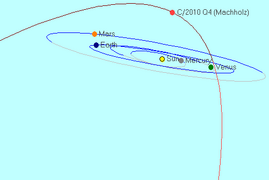
Orbit of Comet C/2010 F4 (Machholz) and the inner planets. Created with C2A.
Don
Machholz of Colfax, CA found his 11th comet on the morning of Tuesday,
March 23rd. What sets Don's 11 discoveries apart from the other comets
found recently is the way it was found. Nowadays comets are found by
computers analyzing thousands of digital images. Only after the
computers have sorted through the data is there human intervention to
confirm that the object being flagged as a comet is really a comet.
Don, on the other hand, has found all 11 of his comets the
old-fashioned way. With no help from computers or digital cameras, Don
finds his comet by peering through his telescope and identifying faint
fuzzies that shouldn't be there. In fact, it is the first visual
discovery of a comet since late 2006.
Comet C/2010 F4 (Machholz) is currently 11th magnitude. At
this brightness, only observers with moderate-sized telescopes under
dark skies will see it. Though the orbit is still somewhat uncertain,
the comet appears to reach perihelion in early April at a distance of
~0.6 AU from the Sun. Unfortunately, it will not get much brighter. In
fact, seeing it will only get more difficult as the comet moves closer
to the Sun. Its increasing proximity to the Sun and the bright Moon now
located in the morning sky means even advanced observers will have a
hard time seeing it after a few days. It is possible the comet may only
be observed for a week or so and then lost for the ages.
The image above shows the orbit of the comet. With an
inclination of ~90 degrees, its orbit is perpendicular to the orbits of
the planets which is not unusual for a long-period comet. The big
question is how was this comet missed by all of the professional
asteroid/comet surveys. Nowadays most comets are found while very faint
(17-19th magnitude) and a few years before perihelion. This comet
probably escaped detection because it was located near the Milky Way
for the past year. The Milky Way is so full of stars that the current
crop of asteroid/comet surveys have a difficult time finding any
objects there. As a result, many surveys avoid the Milky Way all
together.
Congrats to Don Machholz! And thanks for showing us that
persistence (he hunted for 607 hours since his last find in 2004) and
old-fashioned comet hunting can still pay off in this era of computers
and automation.
Joel Achenbach
The Washington Post
Sun, 28 Mar 2010 00:00 EDT
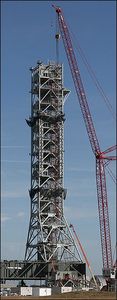
A $500 million mobile launch tower for NASA's Constellation program. The rocket it's meant to launch might never be built.
Cape Canaveral, Florida -- Anyone need a $500 million, 355-foot steel tower for launching rockets into space?
There's one available at NASA's Kennedy Space Center. Brand new, never been used.
The mobile launcher has been built for a rocket called the Ares 1. The
problem is, there is not yet any such thing as an Ares 1 rocket -- and
if the Obama administration has its way, there never will be.
President Obama's 2011 budget kills that rocket, along with
the rest of NASA's Constellation program, the ambitious
back-to-the-moon effort initiated under President George W. Bush.
People here were shocked when they heard the news last
month. They were already facing the imminent retirement of the aging
space shuttle, and the likelihood of thousands of layoffs in the
contracting corps but many hoped to find a Constellation job, stay on
site and essentially just switch badges.
Now suddenly, they're looking at no shuttle, no Ares 1, no
NASA-owned spaceship of any kind in the near future. American
astronauts for years to come will hitch rides to space on Russian
rockets.
"It's almost like losing manned space flight," said Michele Kosiba, 44, a quality inspector for United Space Alliance.
The space center is a unique place, built on a flat expanse of
marsh and scrub that knuckles into the Atlantic. Long, straight,
government roads are lined with ditches patrolled by alligators. Launch
towers stand sentinel on the horizon. From here, the United States
launched some of its most spectacular national achievements. But the
decision to kill Constellation has shrouded this part of the world in
an unfamiliar gloom.
People are dismayed and bewildered. Obama has gotten the
message and will fly to the Kennedy Space Center on April 15 to hold a
space conference and a town hall meeting. He
is certain to point out that his budget actually boosts funding for
NASA. The new NASA strategy shifts the task of launching astronauts to
low Earth orbit from traditional government contracts to commercial
contracts. If the private sector can create a taxi to space, NASA can focus on new technologies and longer journeys in the solar system.
"We think it's exciting," NASA Administrator Charles F. Bolden Jr., a
former astronaut, said in an e-mailed response to questions. "It will
enable us to do things we can only dream about today. It will foster
new industries, spur innovation, create jobs and lead to more missions,
to more destinations, sooner, safer and faster."
'Cancel Constellation?'
A presidential commission, led by former aerospace executive Norman
Augustine, reported to Obama last September that the Ares 1 would have
limited use and that the heavy-lift rocket necessary for a moon mission
probably wouldn't be ready until 2028. At that point, the panel said,
there'd be no money left in the program for a moon lander or moon
habitat. In effect, the Augustine committee said Constellation, which
has already cost $9.4 billion, was destined for a (metaphorical) crash
landing.
"We could get to the moon and do what?" said Dale Ketcham, a University
of Central Florida professor who runs a think tank called the Spaceport
Research and Technology Institute. "The taxpayers would really be
ticked off: Sixty years later we go back and plant the flag and go
home."
Lawmakers in Congress in both parties, particularly those in districts
with space jobs, have given the Obama plan a cold reception. Congress
still must approve Obama's budget. Until that happens, Constellation
maintains a ghostly existence as "the program of record."
Which means that, every day, workers are still adding elements
to the mobile launcher. Across the country, work continues on Ares and
the new crew capsule, Orion. The Orion launchpad abort system will be
tested later this spring in New Mexico. Even
if Congress sanctions Obama's plan, the administration expects to spend
$2.5 billion just closing out contracts and shutting down Constellation.
NASA employees and contractors on the Cape say they were caught off guard by the new strategy.
"We just pulled the rug out from human space flight," said Jim Bolton,
a NASA manager for shuttle processing. The morning of the announcement,
Bolton said, "People were just truly shocked. 'How can that be? Cancel
Constellation? What are you talking about?' "
Bolton spoke as he stood directly beneath the shuttle
Atlantis, which was jacked up in its processing bay and completely
shrouded in scaffolding and fuel lines. The orbiter is being prepped
for its 32nd, and most likely final, journey to and from orbit. From
below, some of the gray thermal tiles that keep it from burning up upon
reentry are slightly scuffed, but it's still a pretty spiffy spaceship.
"It's such an awesome machine," said Tim Keyser, a mechanical
lead in another orbiter bay. "It's not old. I go in the midbody, it's
pristine. It looks like it rolled off the assembly line."
People here talk of the orbiters -- Discovery, Atlantis,
Endeavour -- as if they are beloved members of the family. There are
only four shuttle flights left, with the last scheduled for September,
though the timetable could slip a few months. Some lawmakers are
scrambling to keep the shuttle flying, perhaps with a drawn-out flight
manifest.
Howard DeCastro, shuttle program manager for United Space
Alliance, the primary shuttle contractor, said the shuttle is flying
better than ever. The main challenge for shuttle extension is
restarting supply contracts that have already shut down. It would take
two years, for example, to produce a new external fuel tank for an
additional shuttle flight. Still, DeCastro said, "there are no
showstoppers in flying the shuttle longer."
What will really hurt, workers say, is the disappearance of the know-how accumulated over decades here at the Cape.
"We lose that knowledge base, it's very hard to get that back,"
adds Chris Loines, 43, a United Space Alliance contractor who has been
launching rockets his entire adult life.
Soon, a taxi to space
The administration has promised to spend $2 billion upgrading
the Kennedy Space Center. But workers here said they don't know what
that means, exactly. They don't want to work on facilities, they want
to work on spaceships. Terry White, a United Space Alliance worker who
supervises the thermal protection system on the orbiters, said that
putting money into KSC without a spaceship is like having a fancy
showroom with no cars to sell.
Ketcham said the decision to retire the shuttle has only recently hit home.
"There was this communal epiphany -- 'Oh my God, they're going to
cancel the shuttle.' And then we plunged into the classic five stages
of grief. And rational thought is not one of the stages of grief,"
Ketcham said.
NASA isn't the only game in town. The Cape is shared by NASA,
the Air Force and commercial rocket companies. On the Air
Force-controlled side of the Cape, one will find the commercial rockets
named the Delta IV and the Atlas V, each with a dedicated launch
complex. And there's a newcomer on the block: the Falcon 9.
This is the rocket built by SpaceX, a private company founded
by Internet tycoon Elon Musk. SpaceX has a contract with NASA to launch
cargo to the space station. The Falcon 9 has never flown. Framed by
lightning towers, the 143-foot rocket is poised on an old Titan rocket
pad, having been raised to the vertical position by two hydraulic
jacks.
The scene is rather calmer than what you'd find at a NASA
site. A low building holds cubicles and a couple of dozen workers. A
few technicians in hardhats can be seen poking around the base of the
rocket. In a hangar where the rocket is built, a lone figure sits at a
desk. The commercial route figures to be cheaper than the traditional
government route to space.
SpaceX would like a modified version of the Falcon 9 to become
the commercial taxi to space. The first test flight could be mid-April,
right about the time Obama visits the Space Coast. Musk has estimated
the chance of success on the first try at between 70 and 80 percent.
The final preparations include the installation of an auto-destruct
system, said Scott Henderson, mission assurance director for SpaceX.
If it blows up, Henderson said, "It's not going to get outside the fence here."
From the SpaceX pad, looking west across the scrub of the Cape, the
visitor can see the new NASA mobile launcher, parked for now near the
huge Vehicle Assembly Building. Could SpaceX use that launch tower?
Conceivably, Henderson said. But it's not really designed for a rocket
like the Falcon 9, he said. SpaceX certainly doesn't need it at the
moment.
NASA officials insist that they could still find a use for the
half-billion-dollar tower even if the Ares 1 never materializes. But
space technology tends to be highly customized. A worker on his way to
the cafeteria the other day was overhead saying he wanted to climb the
mobile launcher "before it becomes an artificial reef."
DeCastro, the United Space Alliance executive, said he doubted the mobile launcher could be useful without the Ares 1.
"It's just a big old tower now," DeCastro said. "I guess you
could sell it to SeaWorld or something and put a big ol' slide on it."
Comment: The administration has promised to spend $2 billion upgrading the Kennedy Space Center.
On the Air Force-controlled side of the Cape, one will find the
commercial rockets named the Delta IV and the Atlas V, each with a
dedicated launch complex. And there's a newcomer on the block: the
Falcon 9.
This is the rocket built by SpaceX, a private company founded
by Internet tycoon Elon Musk. SpaceX has a contract with NASA to launch
cargo to the space station.
How convenient for private enterprise to get a $2 billion upgrade at the taxpayers' expense! Ah, yes, the industrial-military complex - no budget deficits for them!
Could SpaceX use that launch tower? Conceivably, Henderson
said. But it's not really designed for a rocket like the Falcon 9, he
said. SpaceX certainly doesn't need it at the moment. [...]But space
technology tends to be highly customized.
Oh heck! What's another $500 million on top of the $2.5 billion
needed to shut it all down! God knows we sure wouldn't want to use that
money for something on the order of, say, health care!
Copious ammonium may be evidence of a 50-billion-ton strike at the end of the ice age
A new study cites spikes of ammonium in Greenland ice cores as evidence
for a giant comet impact at the end of the last ice age, and suggests
that the collision may have caused a brief, final cold snap before the
climate warmed up for good.
In the April Geology, researchers describe finding
chemical similarities in the cores between a layer corresponding to
1908, when a 50,000-metric-ton extraterrestrial object exploded over
Tunguska, Siberia, and a deeper stratum dating to 12,900 years ago.
They argue that the similarity is evidence that an object weighing as
much as 50 billion metric tons triggered the Younger Dryas, a
millennium-long cold spell that began just as the ice age was loosing
its grip (SN: 6/2/07, p. 339).
Precipitation that fell on Greenland during the winter after Tunguska
contains a strong, sharp spike in ammonium ions that can't be explained
by other sources such as wildfires sparked by the fiery explosion, says
study coauthor Adrian Melott, a physicist of the University of Kansas
in Lawrence.
The presence of ammonium suggests that the Tunguska object was most likely a comet,
rather than asteroids or meteoroids, Melott says. Any object slung into
the Earth's atmosphere from space typically moves fast enough to heat
the surrounding air to about 100,000° Celsius, says Melott, so hot the
nitrogen in the air splits and links up with oxygen to form nitrates.
And indeed, nitrates are found in snow around the Tunguska blast. But
ammonium, found along with the nitrates, contains hydrogen that most
likely came from an incoming object rich in water - like an icy comet.
More than a century after the impact, scientists are
still debating what kind of object blew up over Tunguska in 1908. They
also disagree about whether an impact or some other climate event
caused the Younger Dryas at the end of the ice age. But the presence of
ammonium in Greenland ice cores at both times is accepted.
"There's a remarkable peak of ammonium ions in ice cores from
Greenland at the beginning of the Younger Dryas," comments Paul
Mayewski, a glaciologist at the University of Maine in Orono who was
not involved in the new study. The new findings are "a compelling
argument that a major extraterrestrial impact occurred then," he notes.
Whenever a comet strikes Earth's atmosphere, it leaves behind
a fingerprint of ammonium, the researchers propose. Immense heat and
pressure in the shock wave spark the creation of ammonia, or NH3, from
nitrogen in the air and hydrogen in the comet. Some of the ammonium, or
NH4+, ions generated during subsequent reactions fall back to Earth in
snow and are preserved in ice cores, where they linger as signs of the
cataclysmic event.
Although an impact big enough to trigger the Younger Dryas
would have generated around a million times more atmospheric ammonia
than the Tunguska blast did, the concentrations of ammonium ions in the
Greenland ice of that age aren't high enough.
But the relative dearth of ammonium in the ice might simply be
a result of how the ice cores were sampled, Melott and his colleagues
contend. Samples taken from those ice cores are spaced, on average,
about 3.5 years apart, and ammonia could have been cleansed from the
atmosphere so quickly that most of the sharp spike might fall between
samples.
Comment: For an in-depth study, read Laura Knight-Jadczyk's Meteorites, Asteroids, and Comets: Damages, Disasters, Injuries, Deaths, and Very Close Calls.
Officials say a loud boom was heard -- and felt -- in and around
Highland Park Tuesday evening but the cause of the noise remains a
mystery.
More than an hour after the explosion was heard, firefighters were still unable to determine its cause.
Dozens of calls came in at 8:02 p.m. reporting a "loud sound described
by some as an explosion" in the vicinity of North Avenue 52 and Monte
Vista
Street, Brian Humphrey of the Los Angeles Fire Department said.
Those hearing the sound included members of a nearby fire
station about a half-mile from where the sound seemed to emanate,
Humphrey said.
20 firefighters have combed the area looking for anything out of the ordinary, but have come up empty.
Police theorized the sound could have been a backfire, and some people
even theorized a meteorite, Humphrey said.
"It was far louder than anything we have experienced," Humphrey said.
Roger Hebbert got more than a cake for his 75th birthday this morning;
he awoke to find what he believes is a meteorite that struck just 10
feet from his rural Rist Canyon home.
Hebbert's wife, Bonnie, said she heard a loud swooshing sound
late Monday night and felt a gust of wind through the house, but she
didn't think too much of it because the log-sided home the couple
shares is heated by three different sources, including a woodstove.
"I hollered to him and kidded him if he was burning up the house, but he didn't say anything and I went to bed," she said.
Roger awoke around 5:30 this morning, though, and went outside
to split wood and found what appears to be about a 10-pound piece of
rock that fell to the ground so quickly that it created a funnel in the
ground. Several smaller pieces of rock and small holes were found
nearby. The rock struck just 10 feet from the couple's home.
The couple has called Colorado State University to see if
researchers are interested in looking at the rock, and they hope to
find out more.
If this is found to be a meteorite, Bonnie said this will be
her second such experience. Nearly 60 years ago, her father returned
with a large rock from their property near Livermore, which was a
meteorite.
Roger Marsh
UFO Examiner
Wed, 31 Mar 2010 18:41 EDT
A
Florida couple is debating what could have been a meteor in the sky at
9:32 p.m. on March 30, 2010, after observing the object as a "green
fireball" and under 1,500 feet, according to testimony from the Mutual
UFO Network (MUFON) database.
"We are long time astronomy fans, and we have seen many
meteors," the reporting witness stated. "At the same time, we've never
seen a green meteor (made of copper?) We were also both were surprised
about how slow the object seemed to move. I'd compare it to the speed
of a single engine prop plane, at an altitude of 1000-1500 feet up."
The object was described as the size of a pencil eraser held at arm's length.
The following is the unedited and as yet uninvestigated report
filed with MUFON. Please keep in mind that most UFO reports can be
explained as something natural or manmade. If Florida MUFON State
Director G. Bland Pugh investigates and reports back on this case, I
will release an update.
Florida, March 30, 2010 - slow moving green fireball. MUFON Case # 22579.
My wife and I were just sitting out side enjoying the beautiful
evening. When at 9.32pm we saw this bright green fireball in the sky.
We noticed the object at about an elevation of about 85 degrees, and it continued until it passed the horizon.
If it was a meteor, we never heard any crash and we didn't see
anything on the news about it today. Also, the magnitude (brightness)
of the object never wavered.
We are long time astronomy fans, and we have seen many
meteors. At the same time, we've never seen a green meteor (made of
copper?) We were also both were surprised about how slow the object
seemed to move. I'd compare it to the speed of a single engine prop
plane, at an altitude of 1000-1500 feet up.
The object was about the size of a pencil eraser at a arms length.
I made a little diagram of what we saw...the dotted green line represent the path of the object.
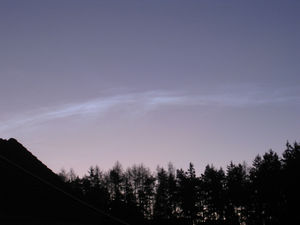
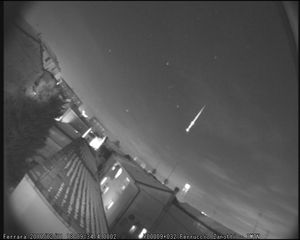
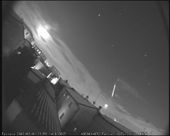
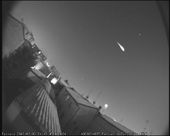
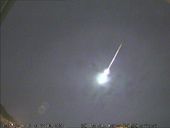
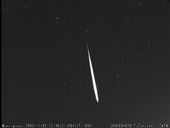
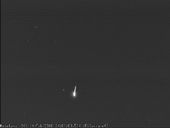
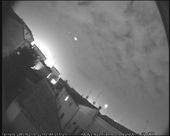
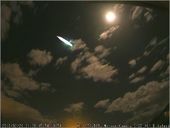
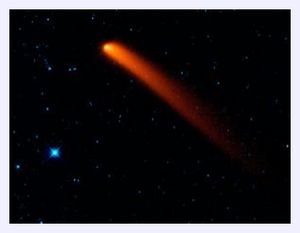
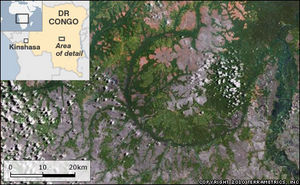
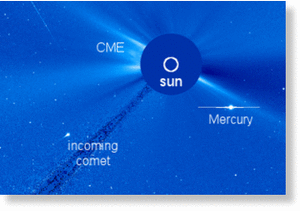
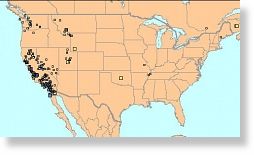
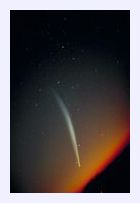

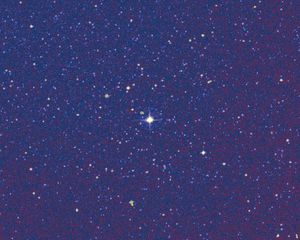
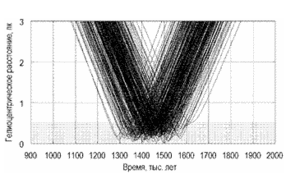

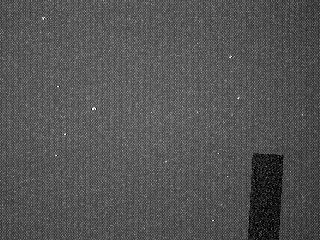
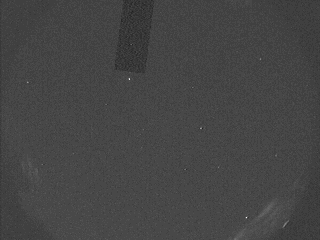
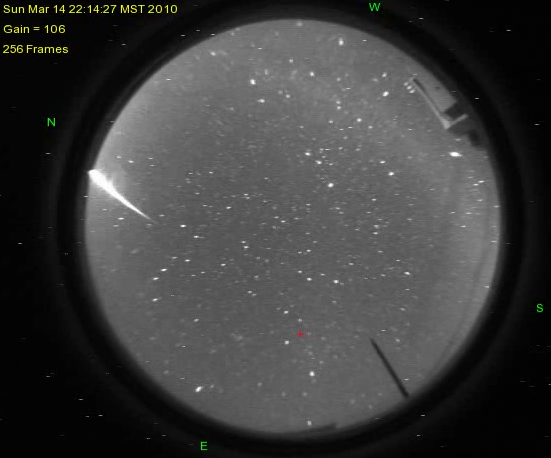
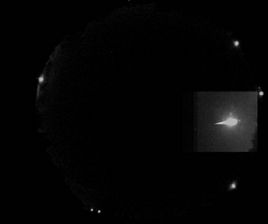
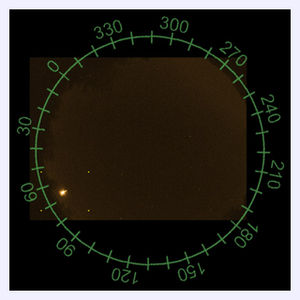
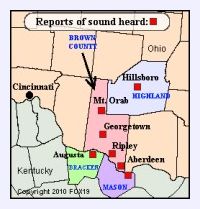
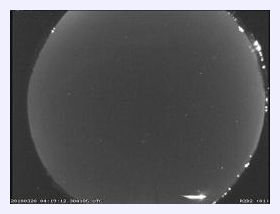

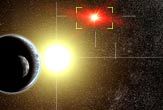

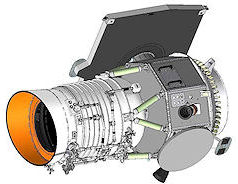
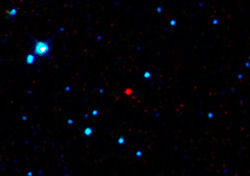
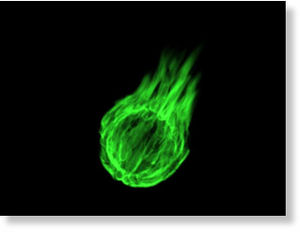
1 comment:
Hello, The "Bolida 2010.02.28. Inarcs (Hungry)" video on YouTube is NOT of the Hungry 28FEB2010 event.
Best Regards, Dirk Ross...Tokyo
www.lunarmeteoritehunters.blogspot.com
Post a Comment